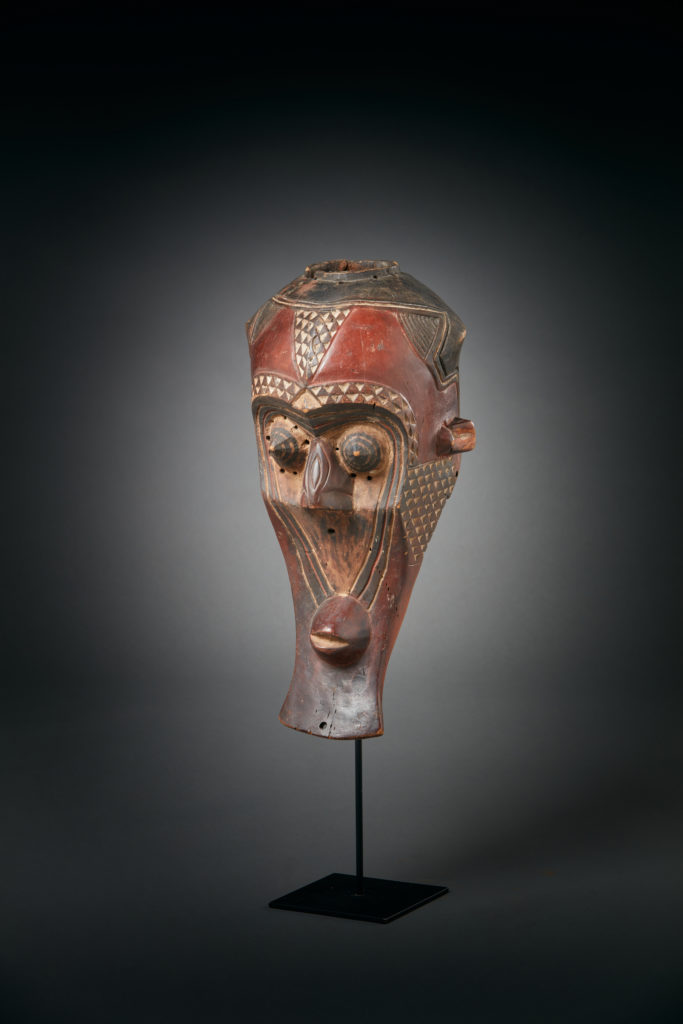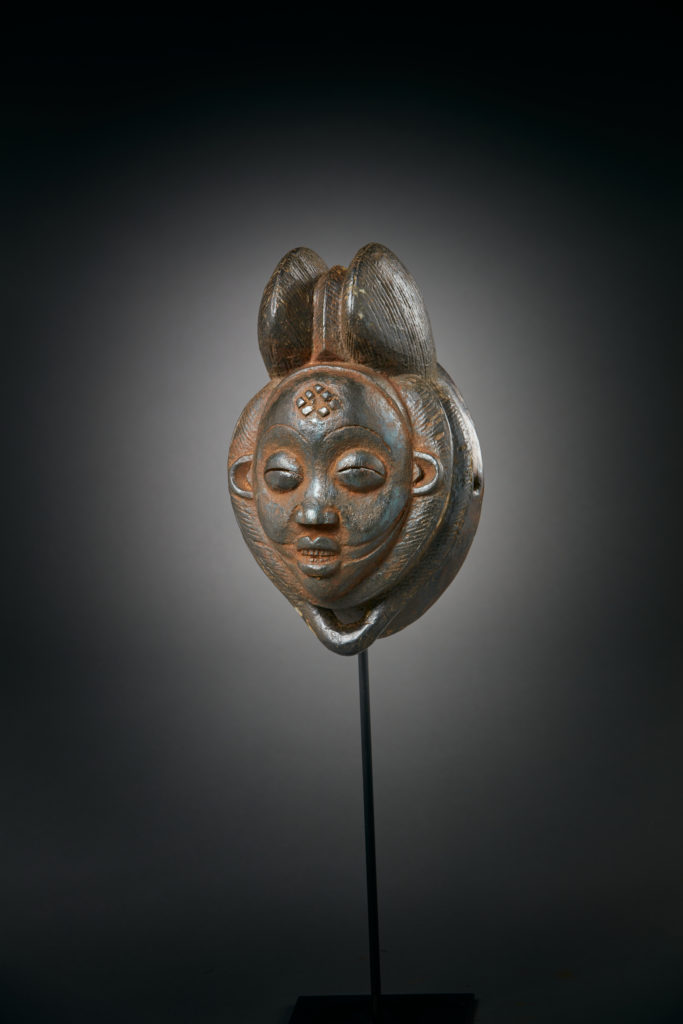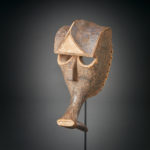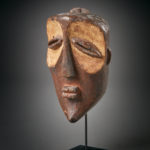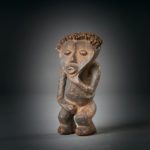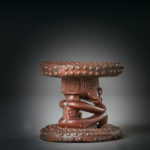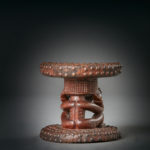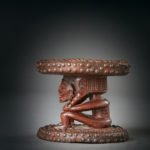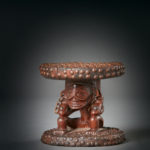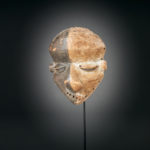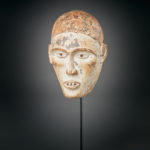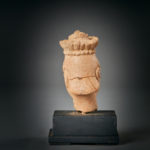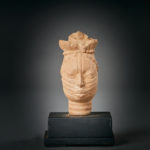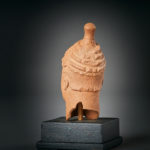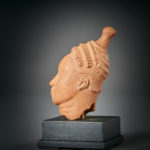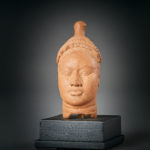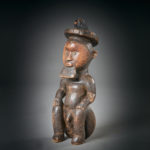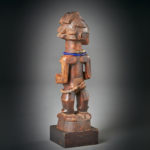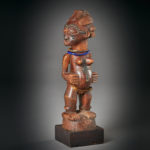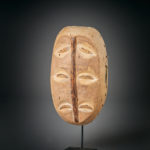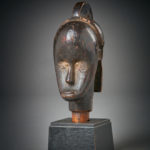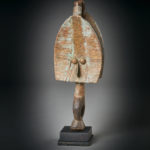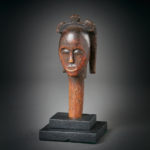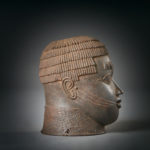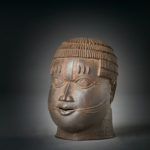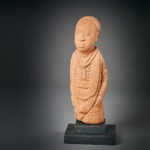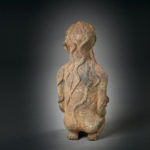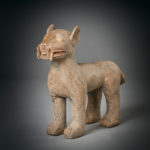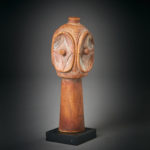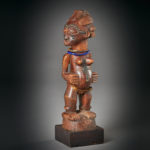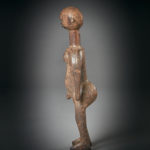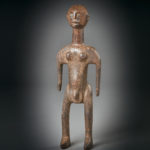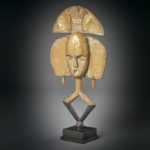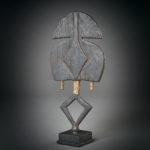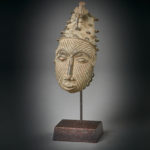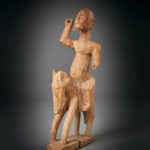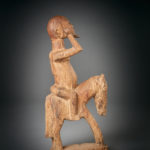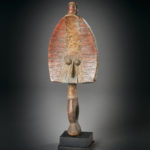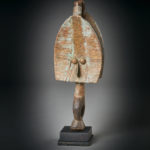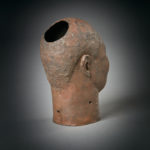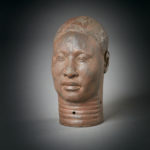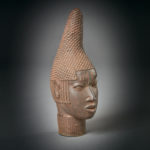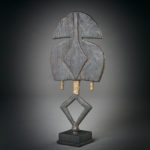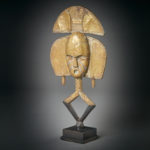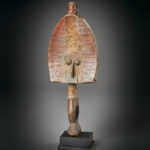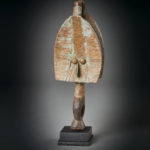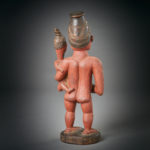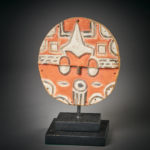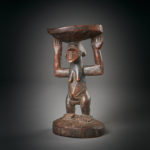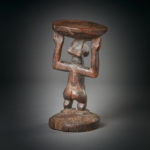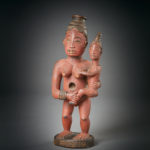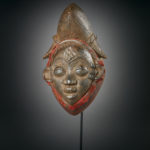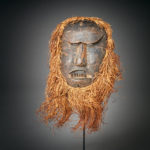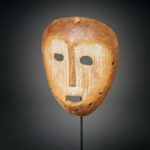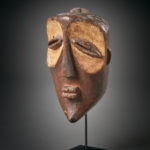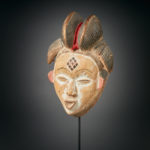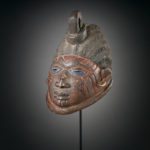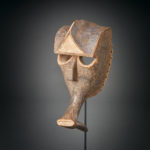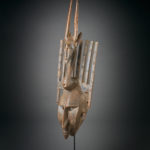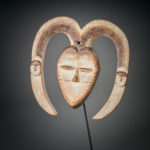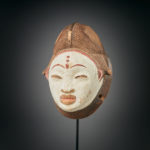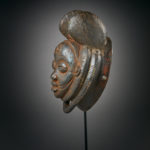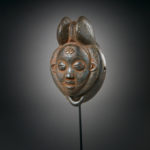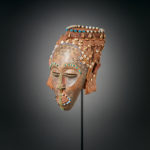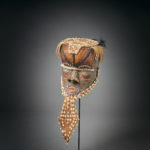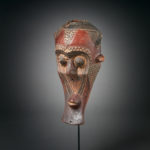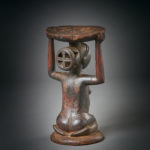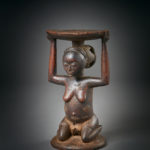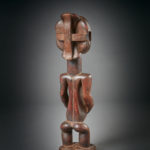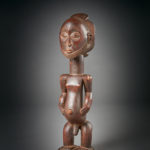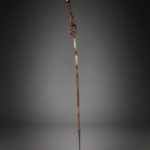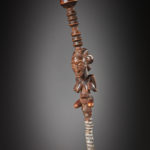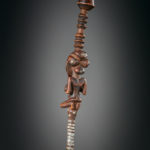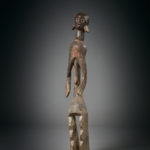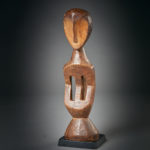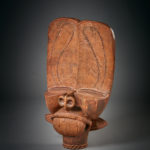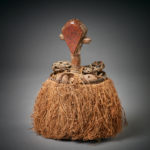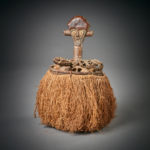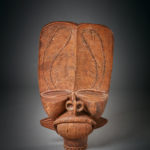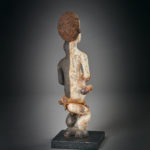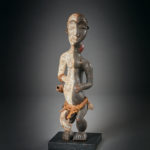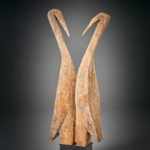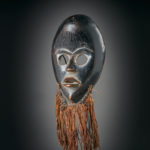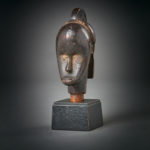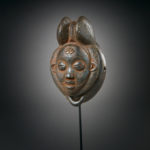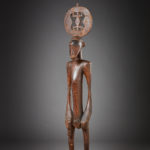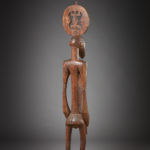African Artifacts Collection
Punu: Black Ikwara Ceremonial Dance Mask with Double Bundle Coiffure
Punu: Black Ikwara Ceremonial Dance Mask with Double Bundle Coiffure
First third of the 20th century
Wood, black plant dye
12 x 8 x 7 in
31 x 20 x 18 cm
Punu people; south of Gabon, Central Africa
The Punu, groups who live in the south of Gabon, are famous for their typically white masks, known as Okuyi masks with their Asiatic slit eyes (which have nothing to do with Japanese masks). Much rarer amongst the Punu are the black masks, carved in a very similar style to the Okuyi masks, but colored black with plant dyes. They are called Ikwara or Ikwara mokulu (night masks). Whereas the white Punu masks are used for dances during the day, at markets, and at large feasts in full-body costumes and on stilts of up to two meters, the black Ikwara or night masks appear only at twilight or dusk. They are used by dancers on shorter stilts of up to one meter in height. The white and black Punu masks also differ fundamentally in their meaning: whereas the white masks, used during the day on high stilts, represent a positive and cheerful aspect (a beautiful girl from the afterlife visits the living benevolently), the black night masks represent a negative and dangerous spiritual background. They only appear at special night-time gatherings, at rituals for the administration of justice, or if the Punu society is threatened by ill-fortune, illness, epidemics, witchcraft, or criminality. Ikwara masks should divert the evil.
This beautiful and old, black Ikwara mask is carved out of lightweight, light-colored wood and wears a high towering hairstyle, as also worn by the women of the Tsogho, the neighboring tribe to the north of the Punu. To the left and right of the tower coiffure hangs two short, relief-carved plaits and, on these two large, white glass beads on knotted leather bands. Above the forehead runs a vertical scarification mark to the highly arched eyebrows. The mask is depicted with a double coiffure bundle, with diamond-shaped scarifications on the center forehead. The hair-bundle coiffure extends in braids on each side of the face that hang under the chin with an opening loophole. The eyes correspond to the Asiatic slit style of the Punu. Below the short, slightly curved nose is a beautiful, reddish-brown mouth. From both corners of the mouth extend inset scarification marks, lancet-shaped, which display the traces of original white coloring by means of kaolin. The neck of the mask is emphatically broad and strong, as the mask costume would be pulled over it and attached to it. Overall, an unusually beautiful, old Ikwara mask of the Punu, with an impressive, shiny usage patina on its front side and rear (inside). According to information of the consignor, this black Punu mask was purchased between 1920 and 1940 ‘in situ’ in south Gabon.
The mask is depicted with a double coiffure bundle with diamond-shaped scarifications on the center forehead. The hair-bundle coiffure extends in braids on each side of the face and ends under the chin with an opening loophole. Tribal scarification on each side of the mouth. According to information of the consignor, this black Punu mask was purchased between 1920 and 1940 ‘in situ’ in south Gabon. Since then, in a French private collection with serial numbers L9460 of the ancient collection and later purchased by Maxwell Price
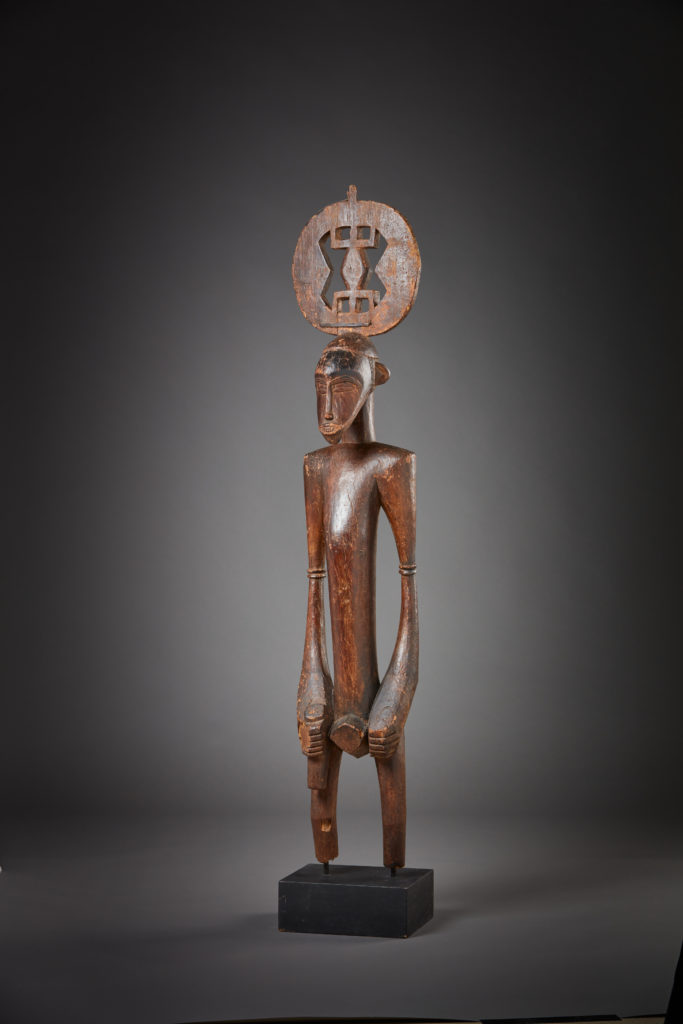
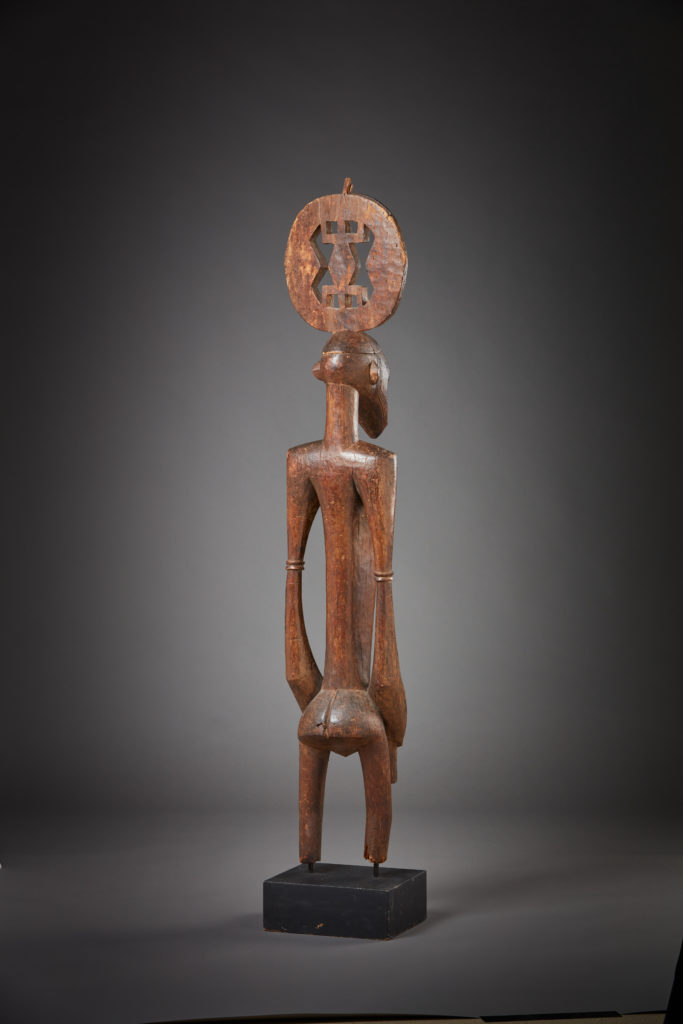
Senufo: Deble Ritual Rhythm Pounder
Late 19th to the first third 20th century
Wood, black pigmentation with rich patina, iron bands to reinforce the repair of the top circular disk
62 x 11 x 9 in
157 x 28 x 23 cm
Senufo people; Region of Sinématali, Ivory Coast, West Africa
This large-scale statue is a very rare work of art among the Senufo, institutional style of professional sculpture, yet on some special occasions large works of art were commissioned by the male Poro society and also by their female counter equivalent society, the Tyekpa society. In the case of the Poro society, large statues of pairs were placed on public display near wooden shrines or shelters where the chosen society’s initiators gathered to celebrate and organize special events and funerals. The Poro society would commission statues such as this one to be carried and used in ritual processions or placed on the ground to serve as a focus point for the ceremonial dancers.
This statue might have also functioned as a large fetish figure or shrine-powered object to which ritual sacrifices were made on the statue. This type of sculpture was used in various ritual functions that would have taken place right before or after a Poro elder member died. The statue would have been carried by initiators of the Poro society who would visit the home of the deceased where sometimes the statue may have been placed beside the corpse of the deceased and covered in a shroud and shown to the public. The statue would then be carried in the funeral procession and accompanied the deceased to their burial place. There it was swung and pounded on the ground around the grave in a rhythmic manner in synchronized time to the music of the Poro society orchestra.
When the ceremony was complete and before nightfall, the grave was covered with soil as one of the Poro society’s members would perform the final gesture with the statue, leaping onto the grave and pounding the soil seven times. This pounding is to ensure that the spirit of the deceased person didn’t linger in the vicinity of the village compound.
The head is of grand dimension and is surmounted by a circular disk with a mythological animal, probably a lizard or a crocodile, depicted in the middle. Both sides of the face are decorated with tribal scarifications. The arms are long, slender and elegantly carved.
Provenance: According to the documents of provenance for this statue, the first European owner was professor Helmet Zake of Heidelberg, Germany. Later, sometime in the late 50s or early 60s, he sold this statue to Emil Storrer, an important private collector of Zurich, Switzerland and later purchased by Maxwell Price
Later in 1981, the Gallery Walu and its director, Mr. R. David, did an expert assessment on the statue after the death of Emil Storrer at the request of his family. In addition, a letter from the International Research Institute of Milan, Italy dates the object to be from the period somewhere between the 1st World War to 1930, which might coincide with the period that the king presented the artifact to Father Emil Bonhomme when he arrived in this region of the Ivory Coast.
These documents by Mr. R. David also state that the professor Helmet Zake had supplied information that the last time the statue was used as a ceremonial death escort of a Senufo chieftain was in the province of Sinématali in the Ivory Coast region of West Africa.
Thus, after further research, Maxwell Price personally found reports and memos kept by Father Emil Bonhomme when he first arrived in this region of the Ivory Coast on December 28, 1895. In these historical documents, Bonhomme gives his report to the church of Memni that states upon his arrival to the vicinity of Sinématali there was a procession composed of the King’s servants; an entire population of the compound had accompanied him to the royal box where the old King was sitting on a piece of wood. As Emil Bonhomme stood surrounded by all of the King’s royal court,the king greeted him and stated that he was the first white man to penetrate his kingdom and that he personally hoped that the mission would do good.
Senufo: Deble Ritual Rhythm Pounder
Sakalava/Vezo Razana Funerary Tomb Sculpture
Sakalava/Vezo Razana Funerary Tomb Sculpture
Early 20th century
Wood
28 x 8 x 9 in
71 x 20 x 23 cm
Sakalava or Vezo people; Region of Morondava, on the western coast of the island of Madagascar
This is a commemorative ancestors (razana) funerary tomb sculpture. The birds that are generally used for funerary sculpture normally depict the unique bird species that are indigenes of the Morondava area and are the type of bird that returns at the end of the day to the same location. This figure would have originally stood at the opposite corners of a rectangular, box-like wooden structure in the cemetery—at the sacred northeast corner, of the grave if it would be male or female depending on the gender of the deceased. The northeast is the position and the place where the sun rises, and is also associated with the dawn and most propitious or favorable events.
This statuette depicts a carving of a Janus-style two-bird figure executed from one block of wood and not separated or detached from the block. This splendidly carved grave post was crowned by two Janus birds’ figures that served as a mediator between members of the family and their deceased ancestors. The people approaching it had to bring offerings of prayers and libations. The surface of these birds show extensive weathering, most likely a result of the tomb’s location in the forest at a sandy clearing some distance from the village that is visited only for the purpose of burying the dead.
Provenance: Old Belgium collection and later purchased by Maxwell Price
Sakalava/Vezo Razana Funerary Tomb Sculpture
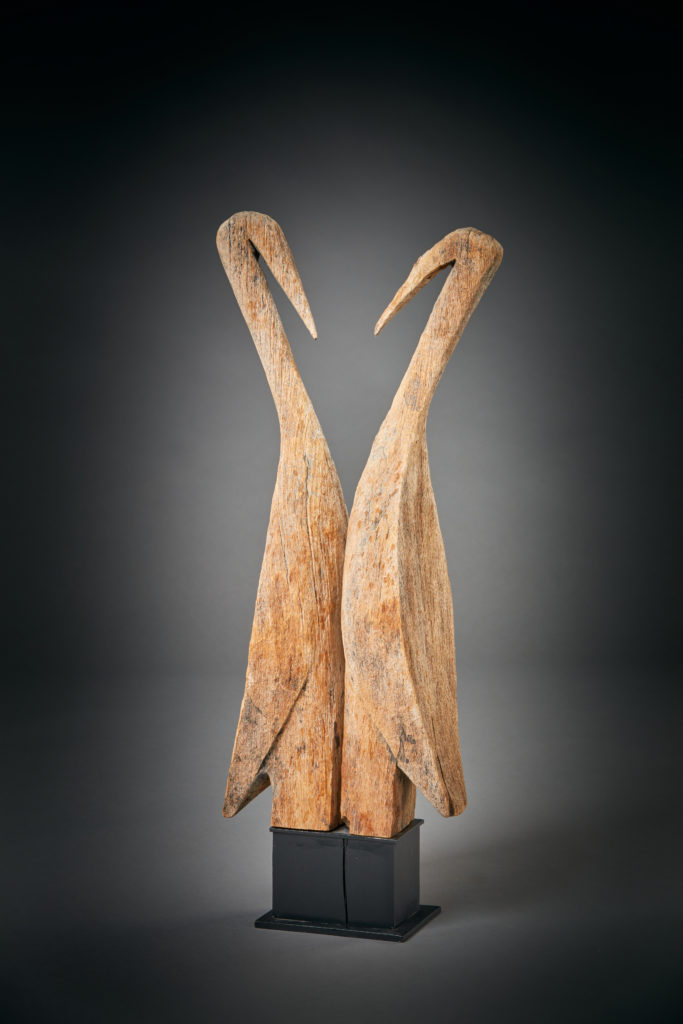
Dan: Gunye-ge Ceremonial Racing Mask
Circa 1910
Wood with black glossy patina, woven fibers
14 x 5 1/2 x 2 in
36 x 14 x 5 cm
Dan people; Region of the northern territories of the Dan people, Ivory Coast, West Africa
The Gunye-ge society held a weekly running contest during the period of the dry season. The race would start off by chasing a young unmasked male runner who would start slightly ahead of the masked person who chased in pursuit of the unmasked runner. They would run through and around the houses of the village until they returned back to the starting point of the race. If the masked runner was able to seize his adversary, the unmasked runner would then put on his own mask and costume then consequently start a match himself against an unmasked runner from the opposing team. In the past, the village chief would have awarded the champion a wife as reward.
This beautifully carved mask depicts a human face that’s feminine for the most part of its execution; the high curved forehead and very fine features reflect a character of high esteem. The large rounded eye-sockets permit the runner a wide field of vision. The mask still shows a woven fiber beard, but the actual costume that once adorned this mask would have been made from strips of cotton that were threaded through the perforated holds along each side of the mask then tied behind the head. The costume was made up of a hood reaching down to the shoulders from its coiffure, with a shirt, pants, fiber bracelets for the arms and ankles, and a short fiber skirt.
Provenance: Ex-private collection of Samir Borro Belgium and later purchased by Maxwell Price
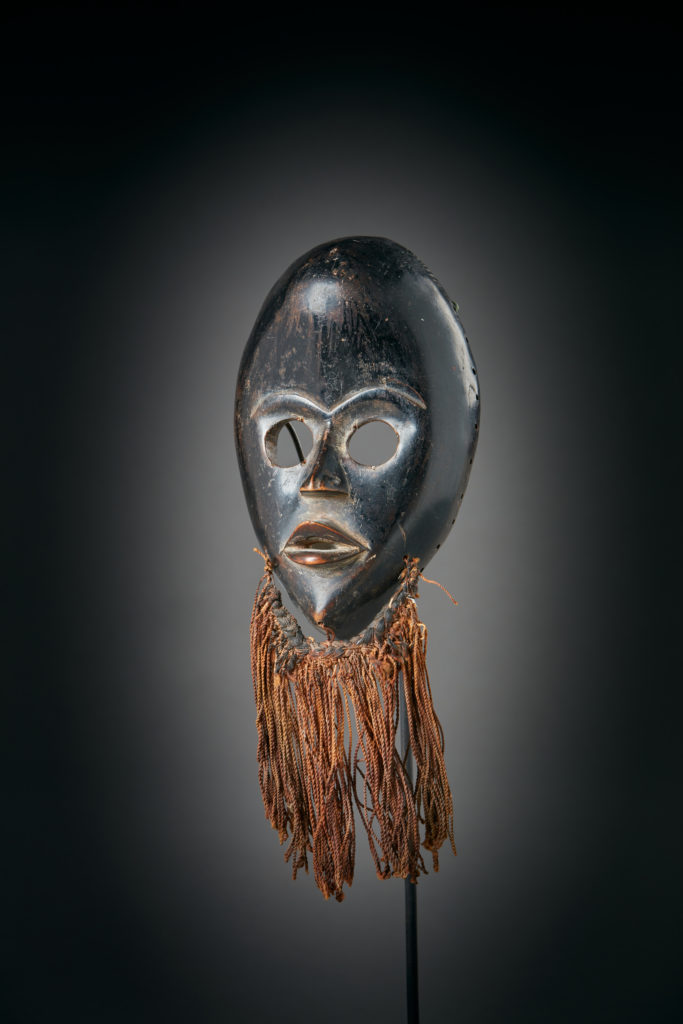
Junkun/Jukun Ancestral Statue
Junkun/Jukun Ancestral Statue
Mid to late 19th or earlier century
Eroded wood with traces of red paint
29 x 8 x 8 in
74 x 20 x 20 cm
Jukun people; Region of the upper Benue River in Nigeria; West Africa
The figure is depicted standing, bearded, with a tribal skull-cap with extensions on each side of the head, holding an axe at the center. Statuettes of this type are found predominantly among the Jukun people in the northwest and represent ancestors, as well as wives and slaves. They are displayed during funerals, agricultural ceremonies, and in times of danger. During these rites, the figures serve as an intermediary between the priest and the ancestor’s world.
The Jukun are an ethno-linguistic group or ethnic nation in West Africa, Nigeria. The Jukun are traditionally located in Taraba, Benue, Nasarawa, Plateau, Adamawa, and Gombe States in Nigeria and parts of northwestern Cameroon. They are descendants of the people of Kwararafa. Most of the tribes in the north central regions of Nigeria trace their origin to the Jukun people and are related in one way or the other to the Jukuns.
Jukun, a people living on the upper Benue River in Nigeria, commonly believed to be descendants of the people of Kororofa, one of the most powerful Sudanic kingdoms during the late European Middle Ages. The ruins of a great settlement to the northeast of the Jukun’s present location are thought to be those of the capital of that kingdom, but the claim has not been thoroughly investigated by archaeologists.
The population speaks the language of the Benue-Congo branch of the Niger-Congo family. The people comprise of a congeries of many smaller groups, each organized on a different basis, although polygynous extended families seem to be the dominant unit.
The Jukun traditionally possessed a complex system of offices, which had both a political and a religious aspect; the priesthood practiced an involved form of religion marked by diurnal and annual rounds of ritual and sacrifice. The king, called Aka Uku, was—until he became a member of northern Nigeria’s house of chiefs in 1947—a typical example of a semi-divine priest-king.
Provenance: Private collection in Southern France later purchased by Maxwell Price
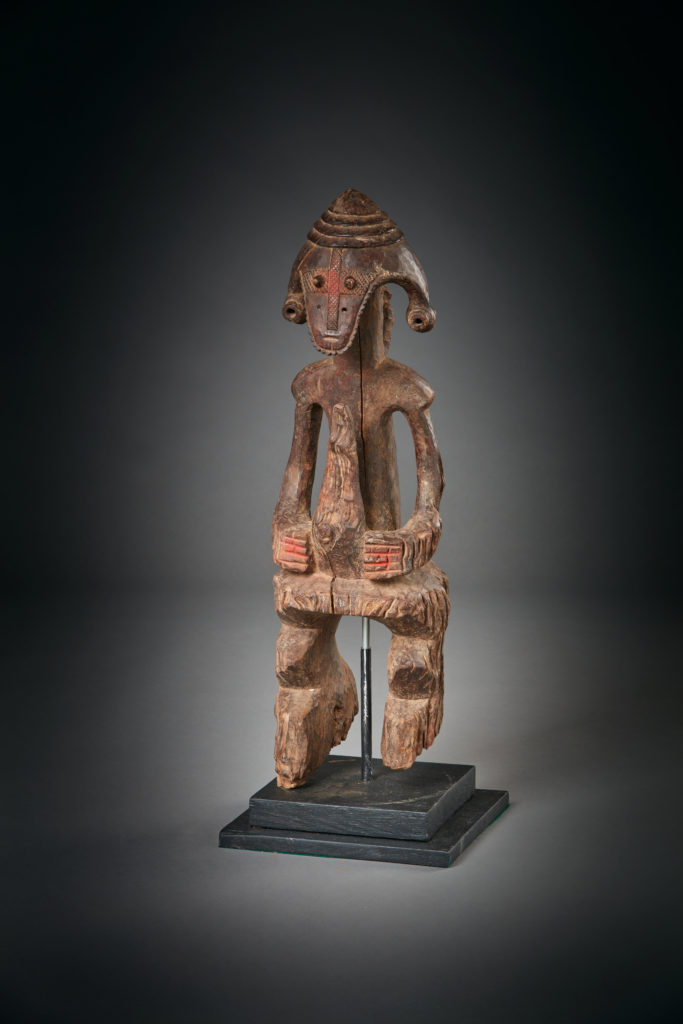
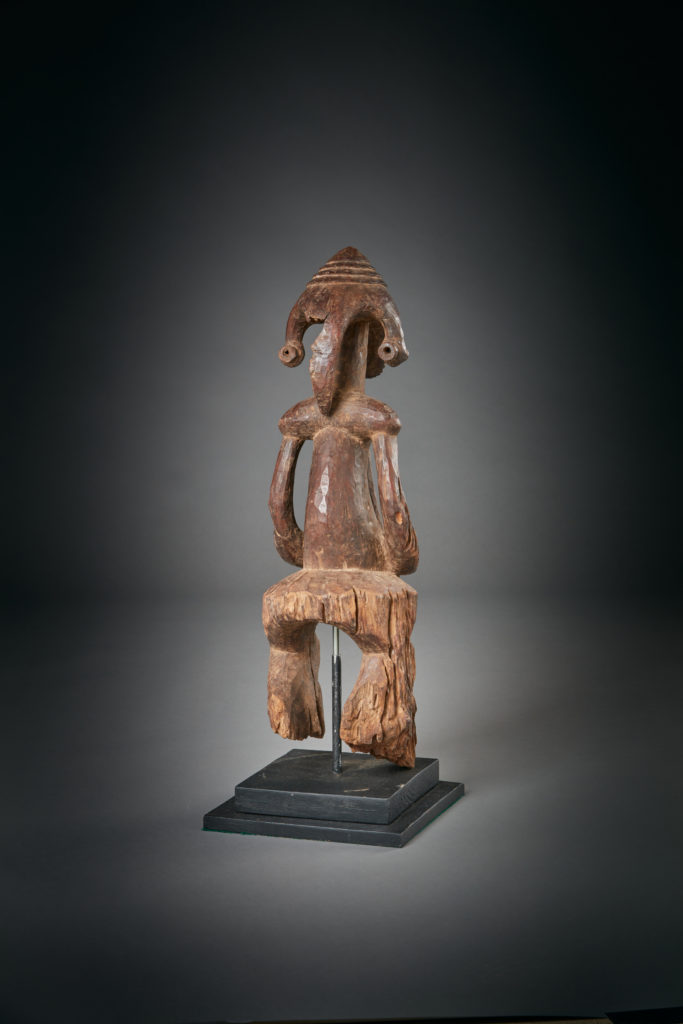
Fang: Nlo-Byéri Reliquary Guardian Head
Fang: Nlo-Byéri Reliquary Guardian Head
Mid to late 19th century
Ancient wood, copper nails
11 x 4 x 6 in
28 x 10 x 15 cm
Fang people; Gabon, Central Africa
This is an important, excellent rendition of reliquary heads depicted with a helmet-type head-crest with two large holes in it possibly for suspension, a bulging forehead, a protruding mouth, and brass or copper nail inlay eyes. This is one of the main examples that influenced many modernist and cubist artists of the late 19th and early 20th century.
This reliquary guardian head made of wood with rich-black patina and copper nails is from the region of Southern Fang tribes and Betsi sub-groups of Gabon. The tribal groups of Gabon share, with variations, a practice of keeping skulls and small bones of lineage ancestors in cylindrical bark boxes or skin-covered baskets surmounted by a guardian figure or head.
The word byeri means ancestor and figures with the same name were made to be placed on the bark boxes called nsek-byeri that contained the skulls of important family members (man or woman). Very few people were allowed to see the contents of the nsek-byeri, and the privilege was usually given to one of the mature sons of the family who was given the responsibility of caring for the byeri objects and maintaining proper rituals. Non-family members were never allowed to see the contents of the nsek-byeri. These relic containers were housed in small huts built for this purpose at a little distance from the village, away from prying or sacrilegious eyes, and were tended by specially appointed elders.
The containers might also include “medicines” such as cowries, snail shells, small animals, seeds, etc., to increase the potency of the ancestral relics. The ancestors’ help was invoked to produce blessings, avert misfortune, and smell out witchcraft or whatever else might be needed in a life surrounded by inexplicable and often dangerous forces. The Fang guardian figures might be whole figures, either male or female, or heads alone.
Provenance: This incredible rare and important artifact was first collected in Europe during the 1930s and later acquired by Michael Wyman in 1970 later purchased by Maxwell Price
The piece has been dated as mid to late 19th century by radiocarbon dating or AMS method analyzed from the laboratories of Illinois State Geological Survey; report by Dr. Hong Wang and expert report by Leonard Kahan.
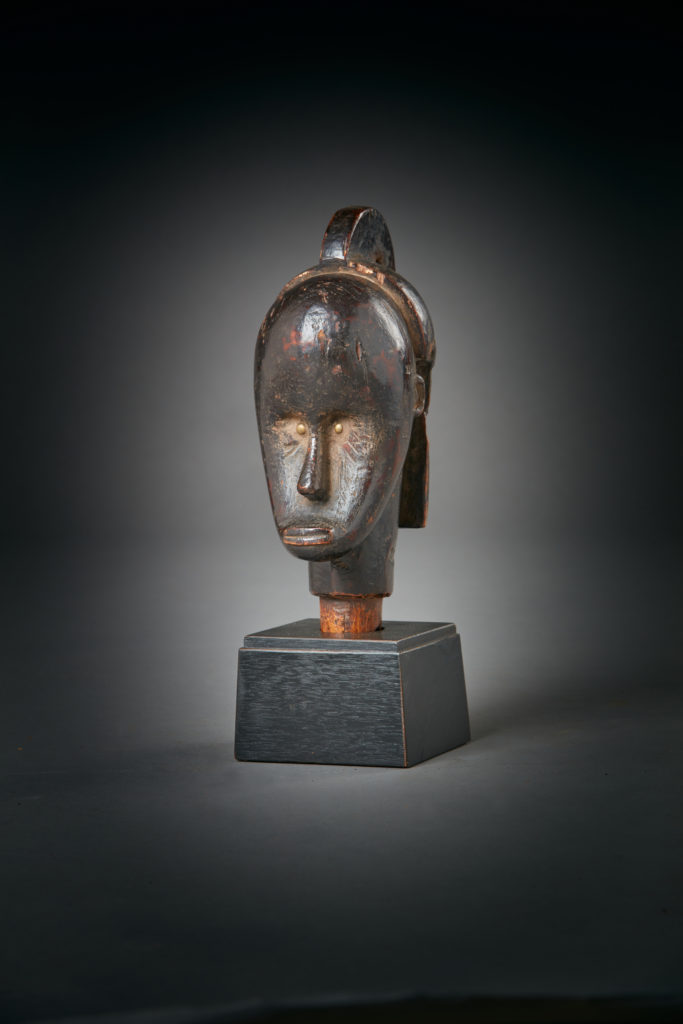

Tchokwe: Royal Ancestral Chibinda Ilunga Figure
Royal Ancestral Chibinda Ilunga Tchokwe Figure
Mid to late 19th century
Ancient wood, brass or copper tacks
15 x 5 x 4 in
38 x 13 x 10 cm
Tchokwe people; northeastern border region of Angola and the Democratic Republic of the Congo
This imposing figure represents the hero Chibinda Ilunga, a royal ancestor of the Tchokwe people. According to legend, Ilunga, the son of a great Luba chief, wooed Lweji, a Lunda chieftain. He introduced into that tribe the concept of divine kingship and also taught the Lunda the art of hunting. From their union, if rather indirectly, came the Mwata Yamvo rulers of the Lunda, to whom the Tchokwe not only paid tribute but also regularly furnished sculptors who produced many kinds of court art almost up to the present day. By association, Chibinda Ilunga became a culture hero and model for Tchokwe chiefs as well. The figure of Chibinda Ilunga came to represent the archetypal chief who maintains the well-being of his people, and he also served as a role model for men in Tchokwe society.
This figure wears elaborate headgear with rolled-up, flanked side elements as a sign of his royal rank likening to the western crown. He holds a staff in his left hand and a carved antelope horn in his right. Since the hunter chief was the most sacred subject portrayed by the Tchokwe, such figures were attempted only by the most skilled artists. This sculpture conveys the physical strength and stealth of the hunter’s body as well as the sensitivity and intelligence of a great leader’s face.
This figure is depicted wearing an elaborate, multi-connected, crown-type headdress attached to the coiffure and worn by only royalty. The crown-headdress appears to be composed of at least two sections; the front is mounted over the top of its head and extends down over the ears having at least four roles. The back side section of this elaborate crown-headdress is executed with a great deal of elegance with sides curling upwards against the flat back of the head. The centerpiece may have been a comb or pin to fasten the headdress together.
The aged, weathered face is depicted with five old brass or copper tacks and two in the upper chest. He holds a staff in his left hand and a carved antelope horn in his right.
The large hands and feet are considered an important attribute in the status of these types of ancestral figures.
Provenance: This incredible, rare, and important artifact was first collected in Europe during the 1930s and later acquired by Michael Wyman, in 1970 and later purchased by Maxwell Price
The piece has been dated as mid to late 19th century by radiocarbon dating or AMS method analysis from the laboratories of Illinois State Geological Survey reported by Dr. Hong Wang and also with expertise reported by Leonard Kahan. Other masterpieces of this genre can be found at the Museu National de Esnologia in Lisbon (see page 113 in the book Sculpture Angolaise, printed 1994) and one in the Kimbell Art Museum in Dallas, Texas.
Pende: Mbangu Dancer Figure
Pende: Mbangu Dancer Figure
Mid to late 19th century
Wood, white and black pigmentation, rope fiber, red abrus seeds, human hair, basket fiber, cloth, leather-fetish bags
25 x 7 x 6 in
64 x 18 x 15 cm
Pende people; Region of central Bandundu province, Democratic Republic of the Congo, Central Africa
This sculptural figure depicts a deformed humpback male dancer, with signs of smallpox. Traces on the skin show boils, eruptions, and localized swelling or inflammation on the sinister side of the neck; and the dropsical pulled-down effect of one side of his face was caused by a paralysis of a facial nerve. The dancer also depicts a swollen abdomen and enlargement of his testicles caused by testicular cancer.
The mbangu dancer represents a bewitched entity that the local sorcerers have possessed. The dancer is depicted as having a humpback, which has been inflicted by the invisible arrows of the sorcerers, causing spells.
The metaphor communicates the scenario and the perception of sudden illness and misfortune. On the dancer’s deter arm, he wears a wooden bell commonly carried by hunting dogs and known for its distinctive hollow sound. This underscores the fate of the dancer, and symbolizes the life, death, and struggle taking place because of the dancer’s human deformity. “Mbangu” is both the hunted and the hunter as he desperately searches for the sorcerers who disabled him.
The mbangu dancer is bewitched, but the Pende people view the world’s attributes and all illness and personal misfortune as the result of the malice of others. What is really at issue is the chronic illness or disability and our response to it.
Provenance: Ex-collection of a Belgium ivory merchant first collected in 1948, then later sold to a professor at the University of Antwerp and later purchased by Maxwell Price

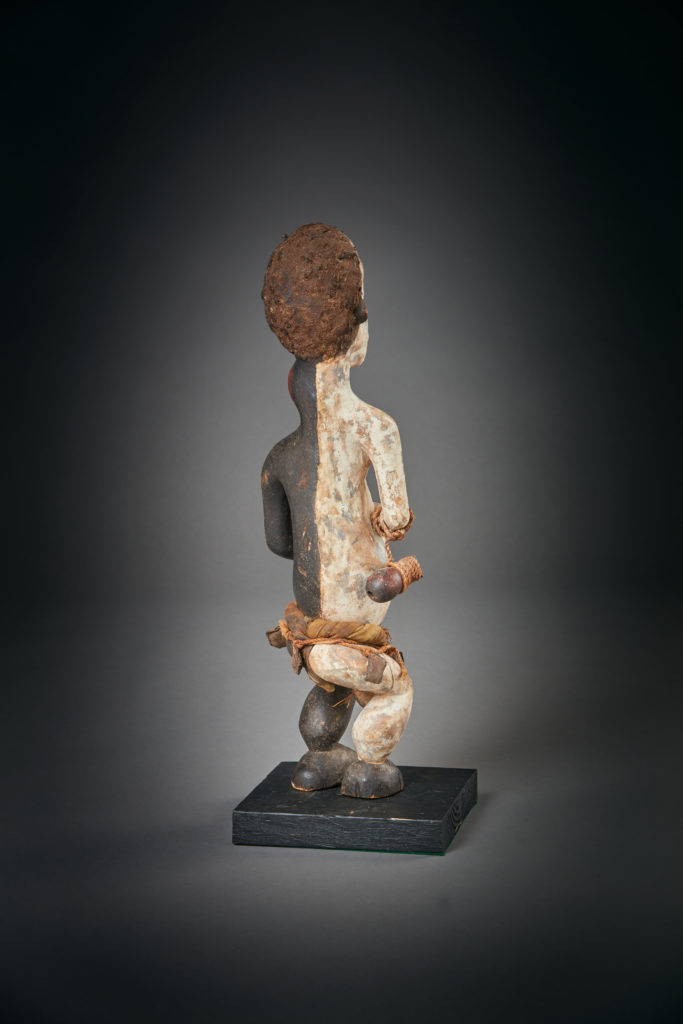
Bamileke: Batcham Ceremonial Dance Mask
Bamileke: Batcham Ceremonial Dance Mask
Late 19th century
Wood with honey-brown patina, red berry seeds
40 x 22 x 10 in
102 x 56 x 25 cm
Bamileke people; Region of the western highlands of Cameroon’s west province, west of the Noun River and southeast of the Bamboutos mountains
This imposing mask represents the head of a hippopotamus dzetshe emerging from the waters. It was used by a high-ranking dignitary of the Bamileke tribe and intervened only on very rare occasions. This mask would participate in ceremonies during the enthronement or funeral of a king or leader. This mask was also used to run the Royal Tso dance and the dance of the elephant ceremonies. The wearer of the mask adjusted the opening of the cylindrical neck over his head wrapped in a hood. This is one of the oldest societies in the region. Depicting a warrior character in the beginning, the mask performs multiple at functions including during the consecration, initiation, and training of Fon, one of the great warriors.
The horizontal plane includes two massive, protruding cheeks that support the large, flat oval eyes on top encircled by thin eyelids.The mask also has a large nose with wide nostrils and a huge open mouth revealing teeth made of vertical stripes. Two little striated ears hook onto the base of the cheeks. The head is supported by a cylindrical neck decorated with a raised circular referring to a string.
Provenance: Illustrated on page 301 in the book African Art in Private German Collections by Karl-Ferdinand Schädler and published 1973 where it states the mask was acquired from the private collection of renowned Bavarian artist Eric Frauenberger of Munich, Germany and later purchased by Maxwell Price
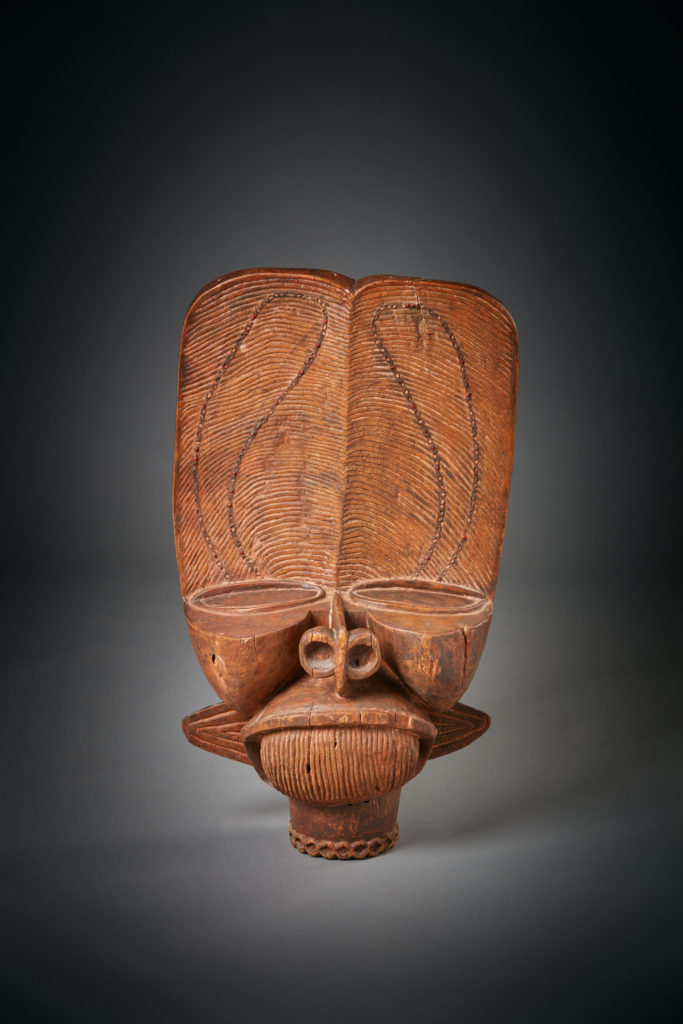
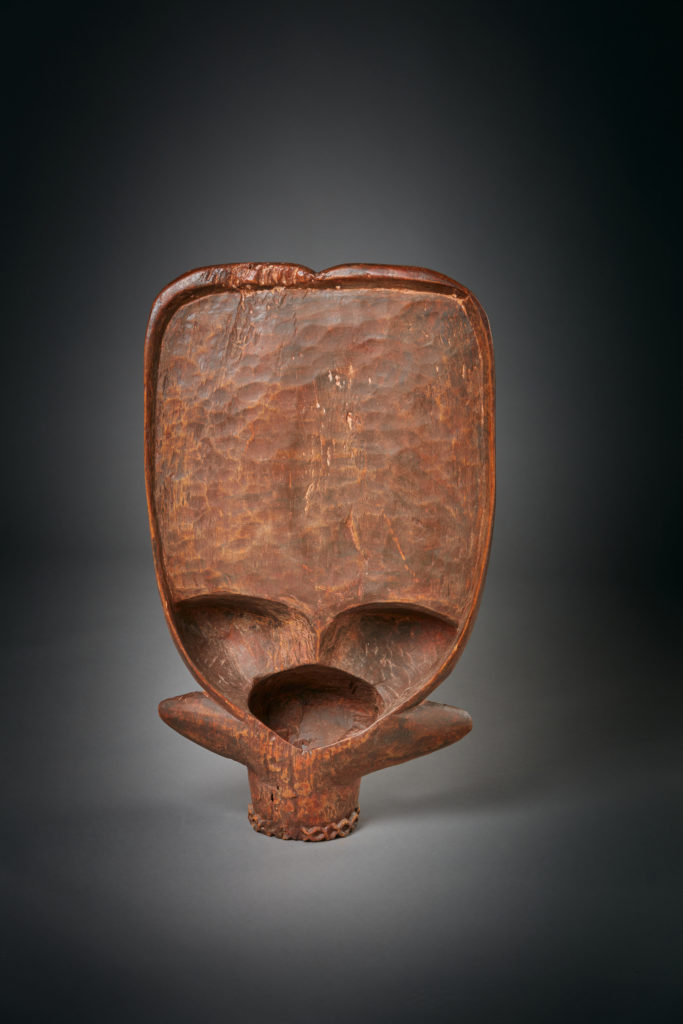
Binji: Ceremonial Dance Mask
Binji Ceremonial Dance Mask
Circa 1930s
Wood, feathers, basketry, red berries, wax or resin
21 x 26 x 10 in
53 x 66 x 25 cm
Binji people; Region of Lusambo, an area in the province of Kasai Oriental, the Democratic Republic of the Congo, Central Africa
This is a very old and beautifully carved wooden helmet mask adorned with a feathered headdress composed of basketry and burlap fiber. Around the eyes are traces of encrusted wax or resin with inlaid red berries. The face is depicted with a large protruding forehead,bulged cheeks, and protruding nose with squared mouth.
It is believed that the Binji originated in the Sangu Lubangu (Lubilash River) region and were a breakaway group of the Kuba tribes who protested against the process of initiation ceremonies. The Binji then joined other small groups such as the Batwa Pygmies.
Provenance: Old Belgium collection and later purchased by Maxwell Price
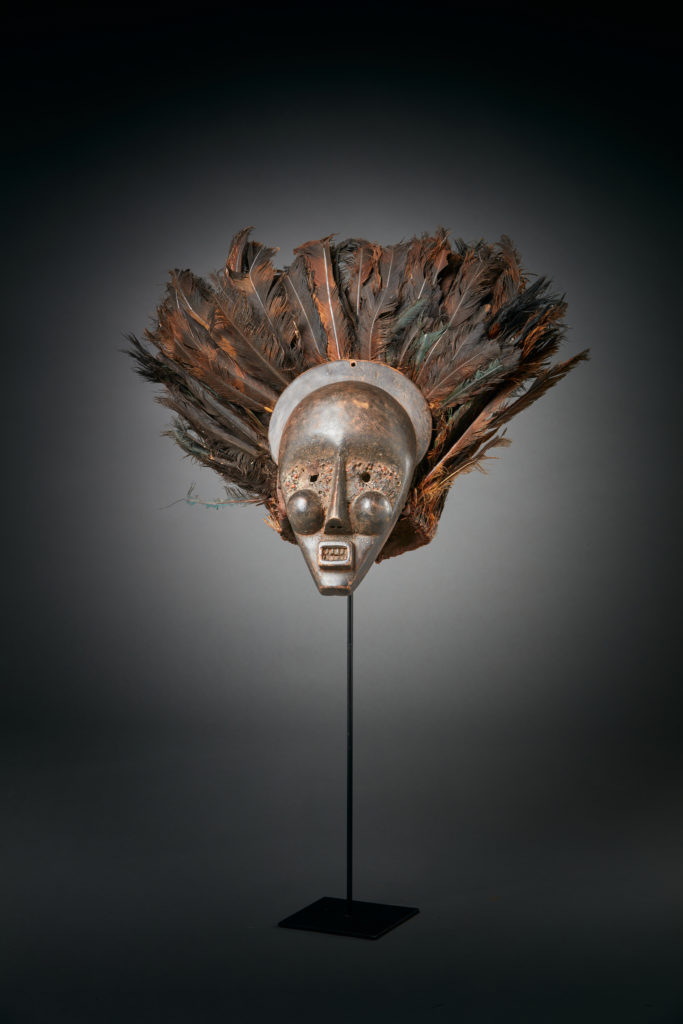
Yombe: Nkisi-Nkondi Fetish Figure
Yombe Nkisi-Nkondi Fetish Figure
Estimated circa 1880–1910
Wood, nails, iron, glass, mirror, bee’s wax, red seeds
21 x 10 x 8 in
53 x 25 x 20 cm
Yombe people; Region of Cabinda and the Democratic Republic of the Congo, Central Africa
The name Nkondi means hunter, which is the mission and purpose of this fetish figure. It functions as a metaphorical device that identifies and hunts down pernicious wrong-doers, such as thieves or others who were believed to have inflicted malefactions or other evil deeds that may have caused sickness and death among the village populace or neighborhood by means of sorceries and the occult.
This Nkondi fetish figure was used in rituals and ceremonies that would invoke the powers of the fetish to hunt down and seize whoever might be responsible for the harm caused and punished that person.
Provenance: Collected in the field in 1948 by a Belgium ex-ivory merchant and colonialist Tony Keys and later sold to and published in an exhibit by professor J. Putteneers of Antwerp, Belgium and later purchased by Maxwell Price
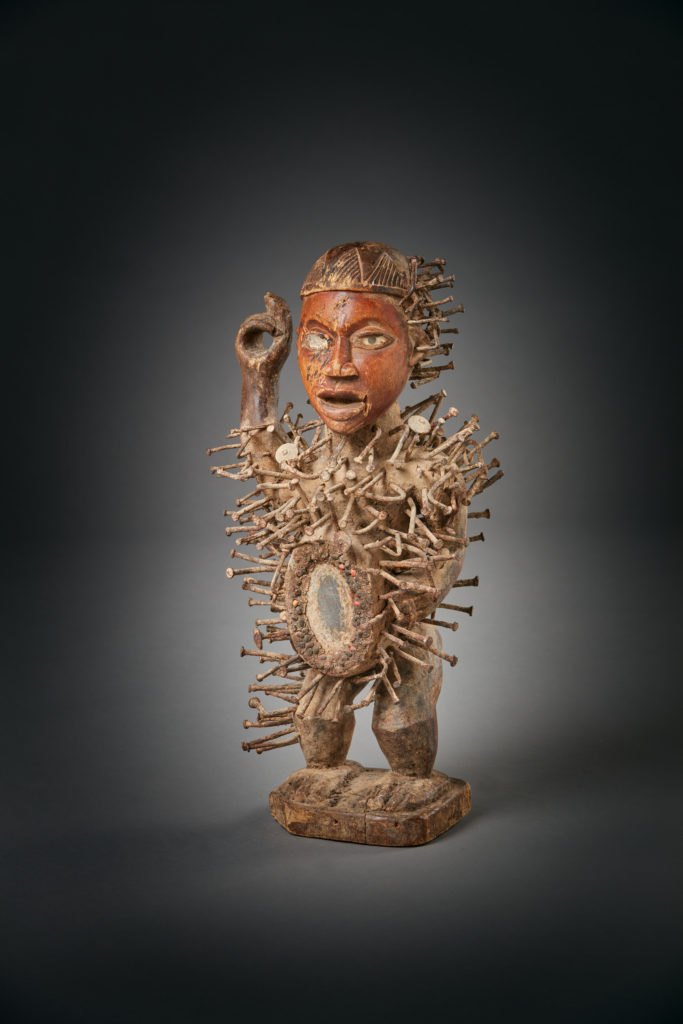
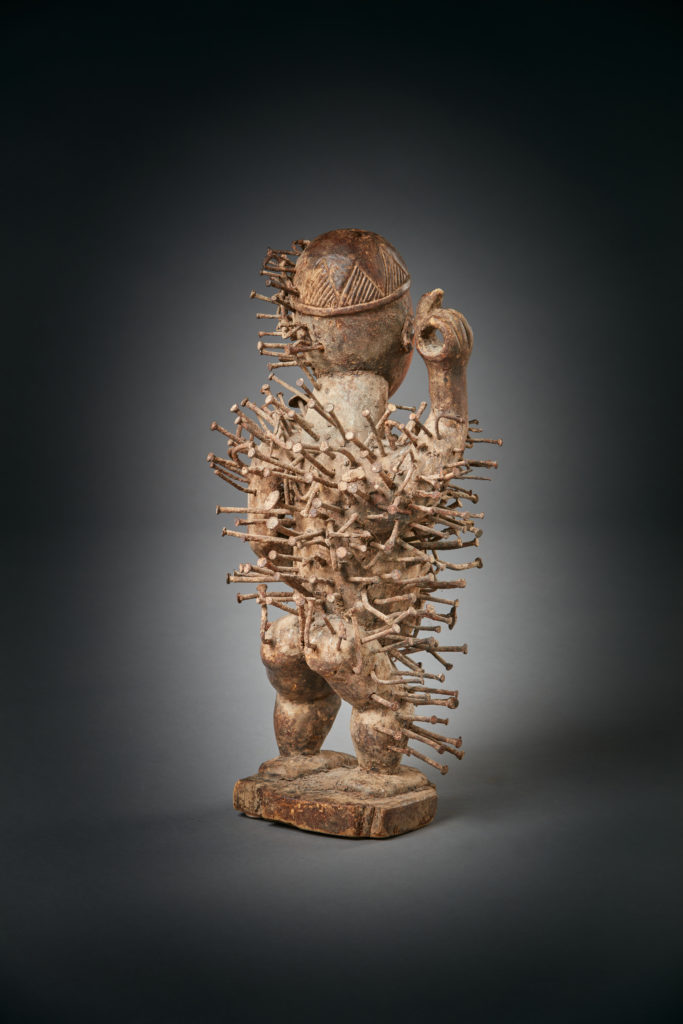
Sango: Mbumbu Reliquary Basket Figure
Sango: Mbumbu Reliquary Basket Figure
Early 20th century
Wood, brass strips, copper, woven basket containing fragments of bones, sea shells, rope fibers, bird feathers, raffia, monkey skull
21 x 12 x 12 in
53 x 30 x 30 cm
Sango people; Province of Gabon, Central Africa.
Reliquaries were used as preservation containers for prominent ancestor chiefs, courageous warriors, and village founders; the relics of the deceased were kept in this type of container basket. The Sango people claim to be descendants of the Kota people, however, they kept their ancestral relics in baskets rather than wooden boxes as the Kota did. These types of reliquaries are represented and protected by a guardian figure placed at the center of the basket and primarily served to prevent uninitiated people from disturbing or gaining access to the ancestral remains. This artifact came from the region of Sango, between the territories of the Bouéngidi, and the Lolo, rivers, neighboring the Mitsogho and Ndzabi people. Ex Antwerp collection and later purchased by Maxwell Price
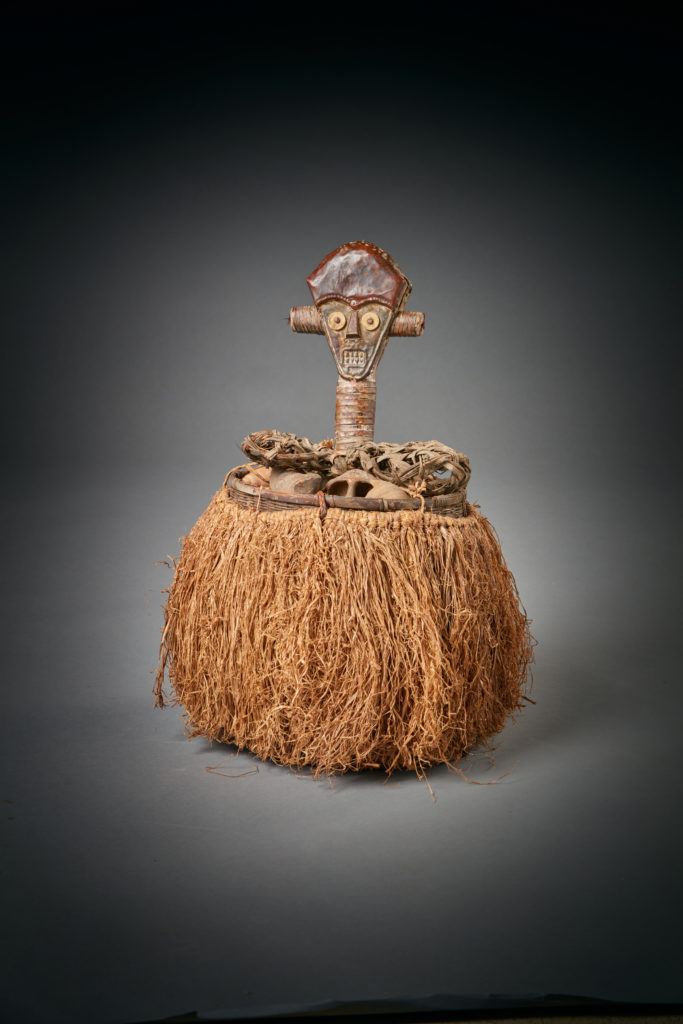

Yombe: Kikongo Bashi, Janus Ceremonial Dance Mask
Yombe: Kikongo Bashi, Janus Ceremonial Dance Mask
Late 19th century
Wood, copper nails, glass, dark vegetable colored pigmentation
11 x 8 x 11 in
28 x 20 x 28 cm
Yombe, Woyo, Solongo, Sundi, Baboma, and Vili tribal people; Border region of Congo and Gabon coast
This is a very rare Janus double-faced helmet dance mask made of wood, copper nails, glass, and dark vegetable colored pigmentation from the regions of the Lukula Lukunga Rivers.
Provenance: Ex-private collection in Northern France; collected in 1959 later purchased by Maxwell Price
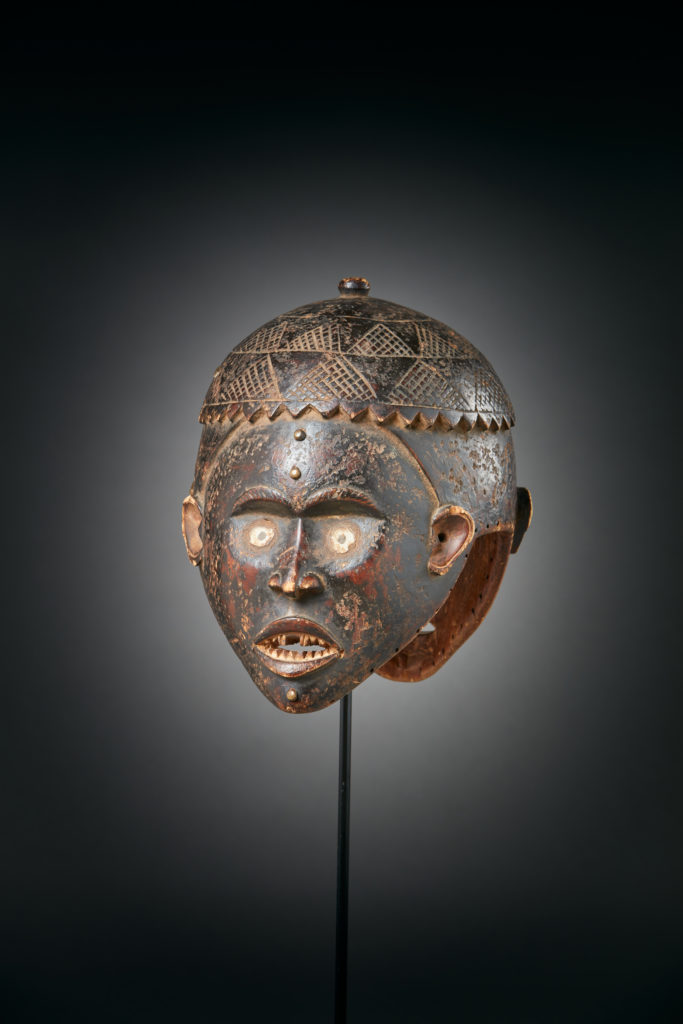
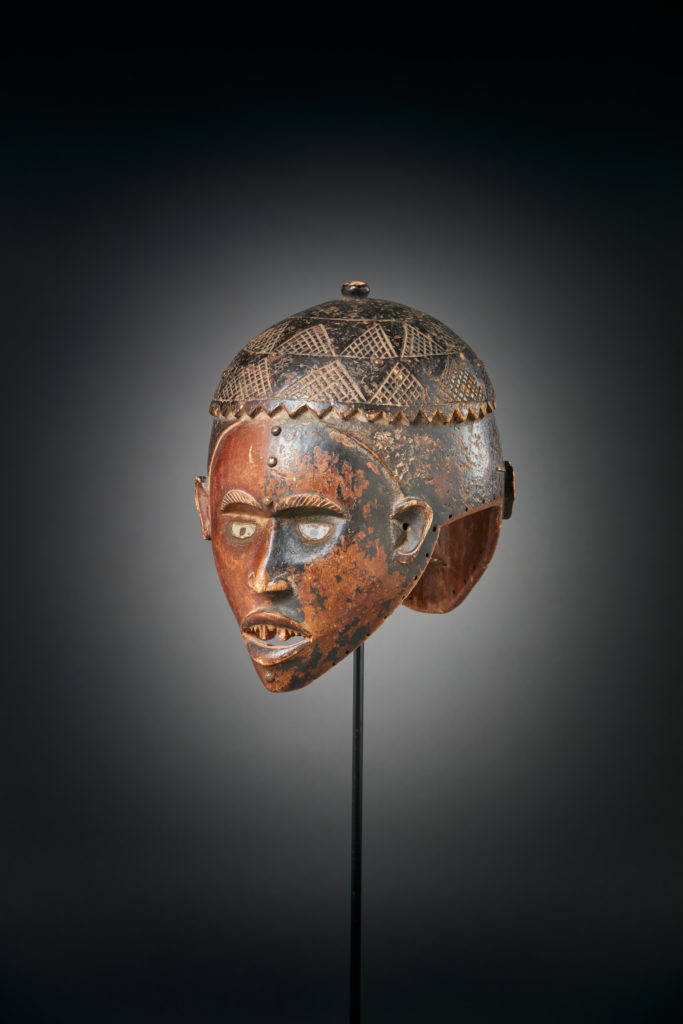
Lega Ancestral Statue
Lega Ancestral Statue
Mid to late 19th century
Wood with traces of white kaolin
27 x 7 x 6 in
69 x 18 x 15 cm
Bakwa Mpegu group; Democratic Republic of the Congo, Central Africa
The Bakwa Mpegu group is thought to be the creators of this statuette from the region of the Democratic Republic of the Congo in Central Africa. This geometric shape figure was used during the Lutumbo Lwa Kindi ritual.
This rare and important statuette with a heart-shaped face has a torso that is carved in a geometrical form depicted with an elongated, cylindrical-shaped base and two symmetrical openings form arms.
Provenance: Ex-private collection of Jean Jacque Rotthier, Belgium. See Neyt, Francois, Traditional Arts and History of Zaire, p.55 for a similar artifact. and later purchased by Maxwell Price


Bambara/Bamana: Ntomo Dance Mask
Ntomo Dance Mask
Late 19th century
Wood, red fabric, nails, copper
28 x 8 x 6 in
71 x 20 x 15 cm
Bambara/Bamana people; Mali, West Africa
The Bambara/Bamana are a large and powerful ethnic group in Mali, West Africa. Both Islamic and traditional religious views are entwined in Bamana culture.
The political structure is patrilineal, meaning positions are inherited and handed down through the male side of the family. Political leaders also control the group’s religious arrangement. Adulthood is earned through the process of six major initiation societies, collectively called the jow, which is used as both a religious and educational system. Bamana males go through all six of the societies in order to be able to marry and start their role in adulthood, while Bamana females go through just one initiation society. Each of these different societies within the Bamana culture has its own unique masks.
The Ntomo society is a five-year period for uncircumcised boys, and the first society of the six they go through to become recognized as men. Boys are taught to accept discipline and endure hardship quietly, which includes ritual flagellation sessions in complete silence. This experience is reflected in the Ntomo society masks, which have small shut mouths or no mouth at all. Mask dancers also carry whips with them, which relates to ritual flagellation. Silence is also taught as the lesson of keeping secrets.
The mask is depicted as a facial mask with circular tattoos and tribal scarification over the human face and a superstructure composed of an antelope head and seven finger-type horns, representing levels of the boys’ society, and tribal scarifications. The social organization of the Bamana is traditionally divided into six age groups, known as Dyow society by means of instruction, examinations, and initiations, one advances from one age group into the next. At these initiation festivals, the masks belonging to the respective age groups make their appearance.
Provenance: Ancient collection of Mert Simpson, serial number #0218 later purchased by Maxwell Price
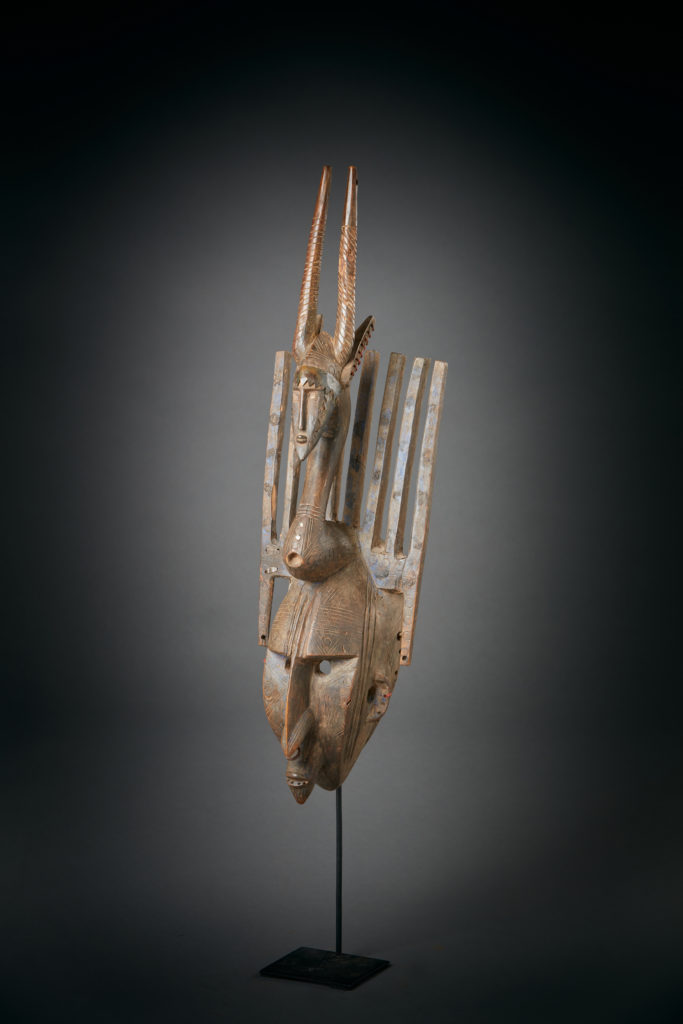
Bembe: Milindi ya Batee Sorcerer’s Statue
Bembe: Milindi ya Batee Sorcerer’s Statue
Approx late 19th century
Wood, kaolin pigment
17 x 5 x 5 in
43 x 13 x 13 cm
Bembe people; Democratic Republic of the Congo, Central Africa
This sorcerer’s statue is from the Alunga society, worshipers of the forest spirits from the region between Baraka and Fizi in the area northeast of the Great Rift Valley, of the Democratic Republic of the Congo. The Bembe come from the northwest forests of the Lake Tanganyika area and are also descendants of the Lega, and Pygmy tribes, and they believe in and worship lineage ancestors.
This is a very rare sorcerer’s statue carved of one block of wood depicted with four surrounding orifices with faces with traces of colored pigmentation and shows a beautiful aged patina.
Provenance: Danish collection, later purchased by Maxwell Price

Punu: Black Ikwara Ceremonial Dance Mask with Single Bundle Coiffure
Punu: Black Ikwara Ceremonial Dance Mask with Single Bundle Coiffure
First third of the 20th century
Wood, black plant dye
12 x 7 x 7 in
31 x 18 x 18 cm
Punu people; south of Gabon, Central Africa
The mask is depicted with a single coiffure bundle; with diamond-shaped scarifications on the center forehead and each side of the eyes or temple. The hair-bundle coiffure extends in red cloth completely around the face of the mask and ends under the chin.
The Punu, groups who live in the south of Gabon, are famous for their typically white masks known as ‘Okuyi masks’ with their ‘Asiatic’ slit eyes (which have nothing to do with Japanese masks). Much rarer amongst the Punu are the black masks, carved in a very similar style to the ‘Okuyi masks’, but colored black with plant dyes. They are called ‘Ikwara’ or ‘Ikwara mokulu’ (‘night masks’). Whereas the white Punu masks are used for dances during the day at markets and large feasts, in full-body costumes and on stilts of up to two meters, the black ‘Ikwara’ or ‘night masks’ appear only at twilight or dusk.
They are used by dancers on shorter stilts of up to one meter in height. The white and black Punu masks also differ fundamentally in their meaning: whereas the white masks, used during the day on high stilts, represent a positive and cheerful aspect (a beautiful girl from the afterlife visits the living benevolently), the black ‘night masks’ represent a negative and dangerous spiritual background. They only appear at special night-time gatherings, at rituals for the administration of justice, or if the Punu society is threatened by ill-fortune, illness, epidemics, witchcraft, or criminality. ‘Ikwara masks’ should divert the evil.
This very beautiful and old black ‘Ikwara mask’ is carved out of lightweight, light-colored wood and wears a high towering hairstyle, as also worn by the women of the Tsogho, the neighboring tribe to the north of the Punu. To the left and right of the tower hang two short, relief-carved plaits and, on these, two large, white glass beads on knotted leather bands. Above the forehead runs a vertical scarification mark to the highly arched eyebrows. The eyes correspond to the ‘Asiatic slit’ style of the Punu. Below the short, slightly curved nose is a beautiful, reddish-brown mouth. From both corners of the mouth extend inset scarification marks, lancet-shaped, which display the traces of original white coloring by means of kaolin. The neck of the mask is emphatically broad and strong, as the mask costume would be pulled over it and attached to it. Overall, an unusually beautiful, old ‘Ikwara mask’ of the Punu, with an impressive, shiny usage patina on its front side and rear (inside).
Provenance: According to information of the consignor, this black Punu mask was purchased between 1920 and 1940 ‘in situ’ in south Gabon. Since then, in a French private collection and later purchased by Maxwell Price

Punu: Black Ikwara Ceremonial Dance Mask with Single Bundle Coiffure
Dogon/N’Duleri Equestrian Statue
Mid 19th century or older
Ancient wood
25 x 6 x 12 in
64 x 15 x 30 cm
N’Duleri-Sanaberi Bandiagara people; Mali, West Africa
This artifact is made with dense hard weathered eroded beige wood with greyish/brown surface. It is very ancient, possibly 18th century or older from the northern villages of the N’Duleri-Sanaberi Bandiagara, a plateau cliff-escarpment in Mali, West Africa.
This statue has characteristics of a very early style circa 15th–16th century distinguished by the absence of clothing, scarifications, saddle, and less pronounced hairstyle or any decorations of jewelry. The rider doesn’t have weapons or hunting paraphernalia, but the horse does have a somewhat elaborate bridle and browband over the neck and head.
The weathered eroded wood with traces of dark brown patina suggests that the statue was a much darker color in ancient times.The right side of the horse’s body and head and the right side of the rider’s body and face is very eroded and suggest that the statue had been laying on one side for a very long time during its antiquity. It is also missing the left arm.
Provenance: The statue was first purchased from an art gallery in London, England, in mid-1938 by an American art collector from northern Illinois, and later sold to a former C.I.A. agent and art collector of whom later was purchased by Maxwell Price
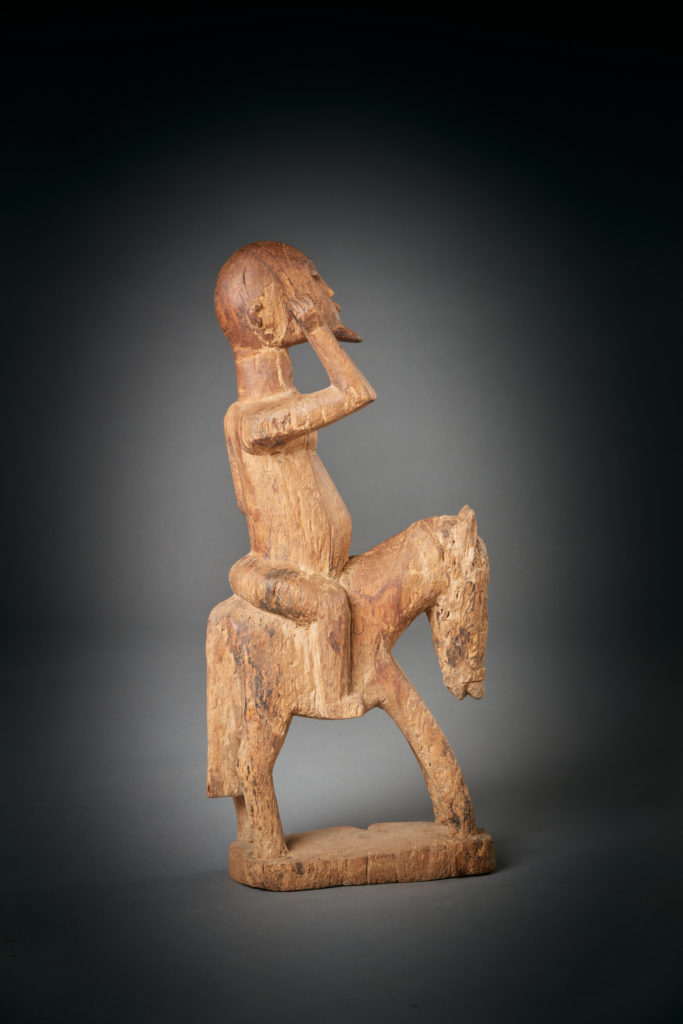
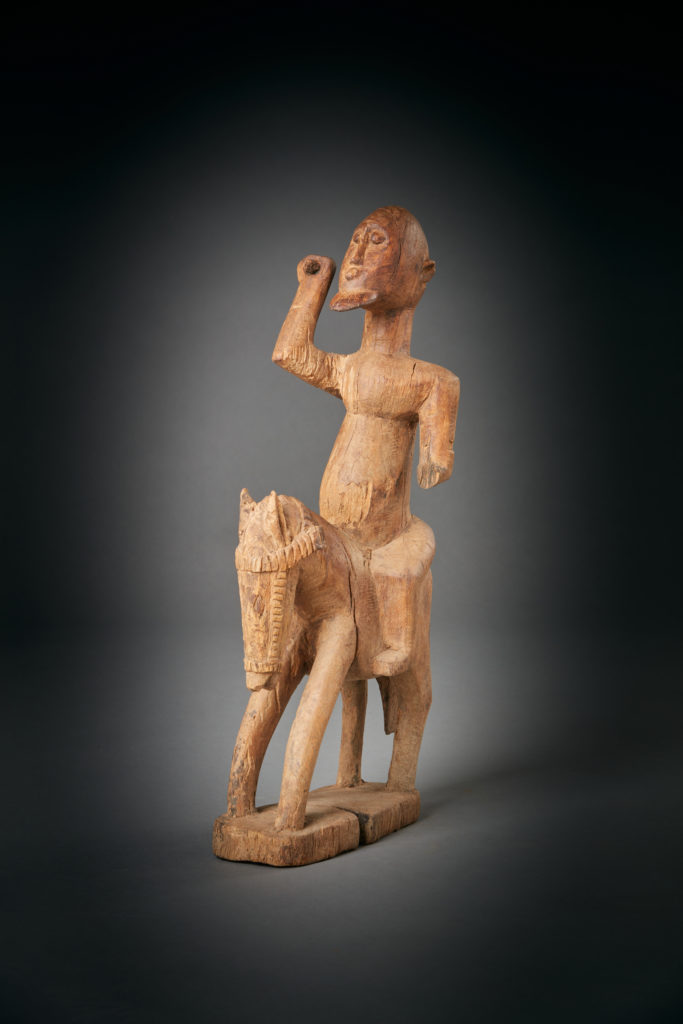
Benin Royal Altar Commemorative Head
Benin Royal Altar Commemorative Head
1531 AD
Brass, bronze, iron
9 x 6 x 7 in
23 x 15 x 18 cm
Benin people; Nigeria, West Africa
The features depicted on these types of effigy heads don’t necessarily represent a commemorative Benin king, but rather effigies of conquered rulers. These objects were displayed on war shrines as trophies of victory. This type of altar head would have normally housed a carved ivory elephant tusk which would have extended from the crown or top opening of the head. Most Benin art forms feature or depict kings or secondary court officials, chiefs, warriors, or musicians. The tradition of casting commemorative heads dates back to and was founded by a Yoruba prince originally from the region of Ife.
The lost-wax casting process is a technique used by Benin sculptors to form the shape of the effigy head in a heat-resistant clay-core. This core is then covered with a layer of wax, in which the sculptor models, carves, and incises an image. Secondly, a thin layer of finely ground liquid clay is painted over the wax model then covered with increasingly thicker layers of clay. When the clay is completely dry, the assembly is heated to melt out the wax leaving an empty image or mold of the sculpted image of the head; for the hot molten metal to be filled in where the wax was and hot metal is poured into the mold. The sculptor must turn the complete assembly upside down to pour the hot molten metal, which is generally a mixture of copper alloys or brass. When the molten metal has cooled, the outer clay casing and inner clay core are broken to remove the casted sculpture or head.
The effigy’s coiffure consists of five braided rows of plaits; the forehead has two rows of three vertical incised tribal scarifications extending from the mouth to the ears. With the center forehead and eyes inlaid with two strips of iron inlay. The collar on the neck represents a stylized coral bead necklace.
Provenance: This artifact is an extremely rare and important archeological find from the Benin civilization. The époque of the Benin civilization is presumed to be from the classic period to between the 13th–16th centuries. The results of thermoluminescence testing (report number 16R030519) conducted by the Kotalla Laboratory research facilities in Germany reports that sampling taken from the core of the cast and on the inside of the nose and eyes shows that this artifact was last fired into its present construction approximately 490-500 years ago, with an actual date reported as 1531 AD, which is consistent with the suggested period of the Benin civilization. later purchased by Maxwell Price
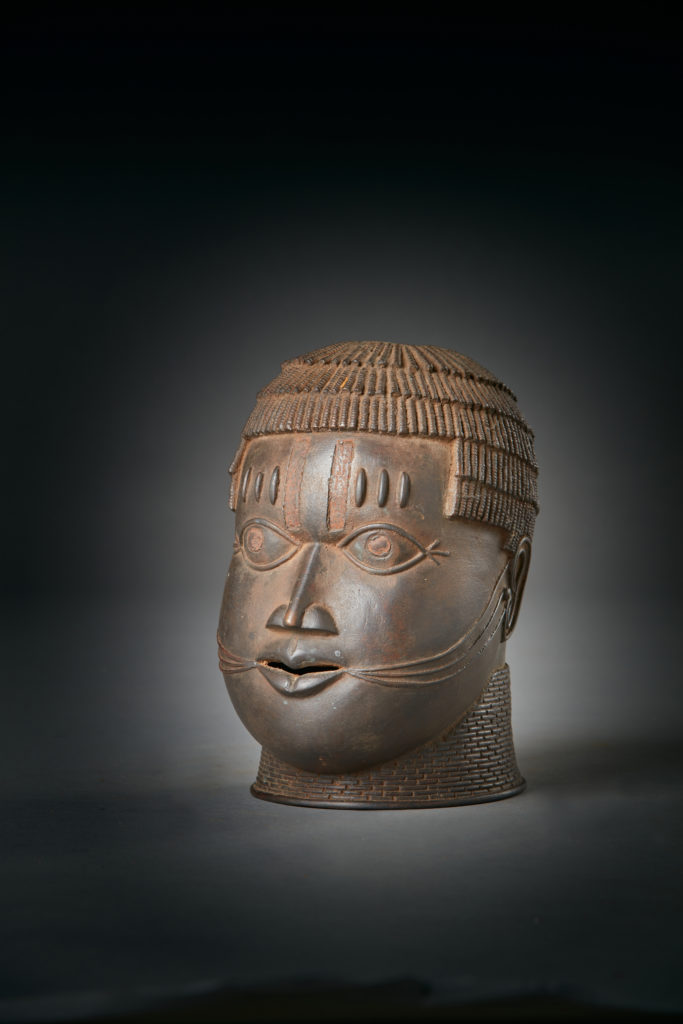

Fang: Funerary Reliquary Guardian Head
Fang: Funerary Reliquary Guardian Head
Mid to late 19th century
Ancient wood
16 x 6 x 6 in
41 x 15 x 15 cm
Fang people; Okono Valley School, Fang people; Gabon, Central Africa
The Kota, Mahongwe, and Mbete tribal groups of the Gabon region all share, with variations, a practice of keeping skulls and small bones of lineage ancestors in cylindrical bark boxes or skin-covered baskets surmounted by guardian figures.
These relic containers were housed in small huts built for the purpose at a little distance from the village, away from prying or sacrilegious eyes, and were tended by specially appointed elders. The containers might also include “medicines” such as cowries, snail shells, small animals, seeds, etc., to increase the potency of the ancestral relics. The ancestors’ help was invoked to produce blessings, avert misfortune, and smell out witchcraft or whatever else might be needed in a life surrounded by inexplicable and often dangerous forces.
The Fang guardian figures might be whole figures, either male or female, or heads alone. This head belongs to the Nzaman-Betsi substyle, located in the valleys of the Okano, Ogowe, and Abanga rivers, which is rated “the most classical” of all Fang statuary (Perrois, 1979). This particular style-type of head reliquary is very rare and similar to the great reliquary head of the renowned Helena Rubinstein collection, lot 213, sold at Parke- Bernet galleries in 1966.
To strengthen their power, Fang Bieri guardian artifacts were ritually anointed with palm oil; some examples like this head have had the excessive oily patina cleaned off by early European collectors, while others Fang artifacts are still very sticky and oily from decades of ritual application of palm oil.
The head is depicted with a long, flared shaft supporting the thick, cylindrical neck of the partially eroded stump or neck, by which it was originally fixed into the basket or box, projected beneath the neck. The oversized, spherical head with a concave, heart-shaped facial plane, the naturally worn oval mouth beneath show the lips are deformed with a cleft-palate, and similarly worn nose. The almond shaped eyes were inlaid with copper pins that have been removed. The coiffure or hair-style is a classic chieftain or important male social figure hairstyle of three braids.
The earliest Gabonese carvings were imported into Europe before 1850, but artistic awareness of their quality came later, in the early years of the twentieth century.
This artifact was collected in 1948 by a Belgium ivory merchant by the name of Mr. Tony Keys and was sold to a university professor in Antwerp, who Maxwell Price acquired the piece from in 1996.
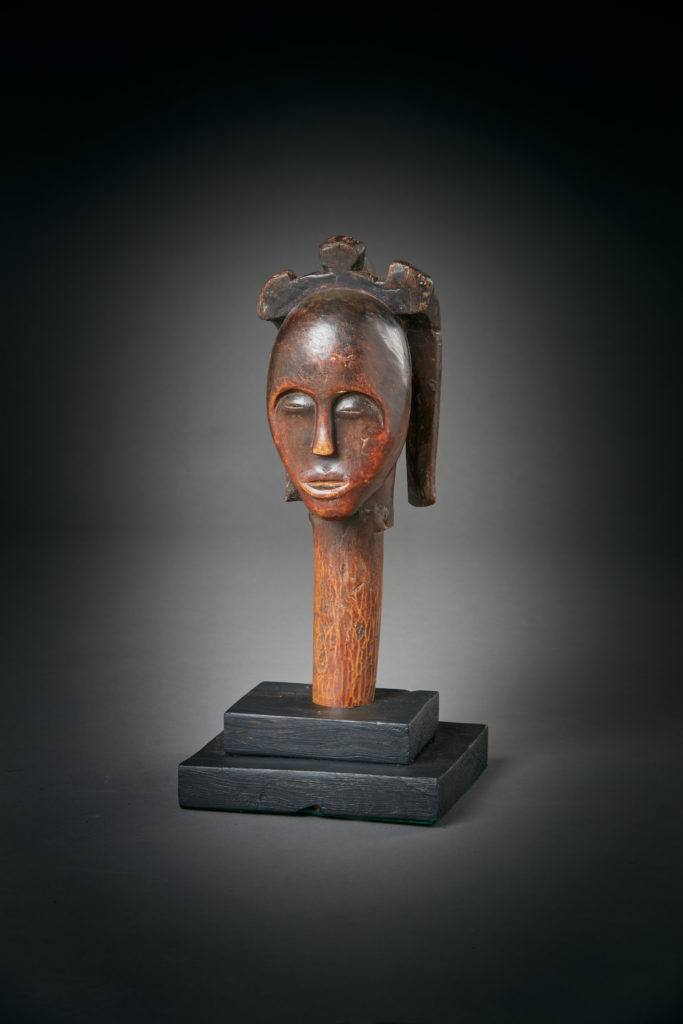
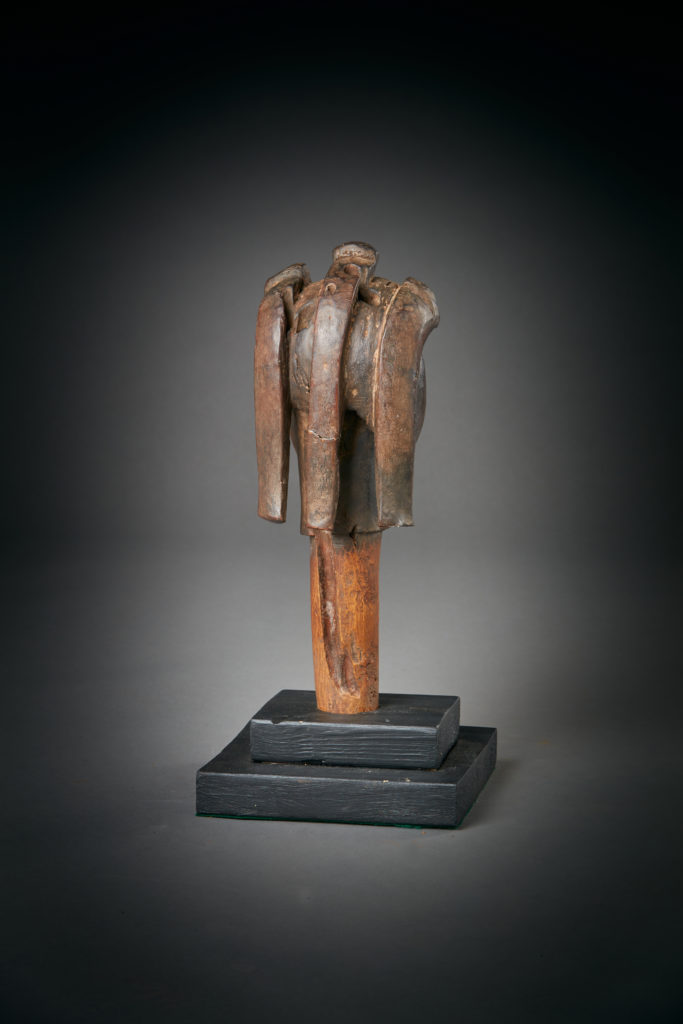
Igbo-Ukwu Bronze Statuette
Igbo-Ukwu Bronze Statuette
Circa 9th century A.D.
Leaded bronze
16 x 6 x 7 in
41 x 15 x 18 cm
Nri and Aguleri people; Igbo-Ukwu, Anambra State, in south-central and southeastern Nigeria, West Africa
The Nri and Aguleri people are in the territory of the Umueri clan who trace their lineage back to the patriarchal king-figure Eri. The Nri and Aguleri and part of the Umueri clan are a cluster of Igbo village groups who trace their origins to a sky-being called Eri. Archaeological evidence suggests that Nri hegemony in Igboland may go back as far as the 9th century, and royal burials have been unearthed dating to at least the 10th century. Eri, the god-like founder of Nri, is believed to have settled the region around 948 with other related Igbo cultures following the 13th century.
The earliest examples of cast bronze artifacts were found in Igbo-Ukwu, Nigeria, in the 9th century. In West Africa, the tradition of bronze casting reached its peak during the great kingdoms periods. The difficult cire perdue technique was used for the creation of different items made of bronze. This lost-wax casting technique is the process of duplicating metal sculpture (silver, bronze, or gold) from an original mold.
The prominent Igbo-Ukwu archaeological site has different parts, including the main burial place with caches and shrines. Archaeological experts discovered the site in 1939 when an Igbo farmer named Isaiah Anozie accidentally stumbled upon several bronze objects. Almost all of Igbo Ukwu bronze art objects were made around the 9th century A.D.
Igbo Kingdom/Nri Kingdom
The Kingdom of Nri is considered to be the foundation of Igbo culture, and the oldest Kingdom in Nigeria.[5] Nri and Aguleri, where the Igbo creation myth originates, are in the territory of the Umueri clan, who trace their lineage back to the patriarchal king-figure, Eri.[6] Eri’s origins are unclear, though he has been described as a “sky being” sent by Chukwu (God).[6] [7] He has been characterized as having first given societal order to the people of Anambra.[7]
Archaeological evidence suggests that Nri hegemony in Igboland may go back as far as the 9th century,[8] and royal burials have been unearthed dating to at least the 10th century. Eri, the god-like founder of Nri, is believed to have settled the region around 948 with other related Igbo cultures following the 13th century.[9] The first Eze Nri (King of Nri), Ìfikuánim, followed directly after him. According to Igbo oral tradition, his reign started in 1043.[10] At least one historian puts Ìfikuánim’s reign much later, around 1225.[
Early History
Archaeological research pioneered by Charles Thurstan Shaw has shown that people were already living in south-eastern Nigeria (specifically Igbo Ukwu, Nsukka, Afikpo,, and Ugwuele) 100,000 years ago. Excavations in Ugwuele, Afikpo, and Nsukka show evidence of long habitations as early as 6,000 B.C. However, by 9th century A.D., it seemed clear that the Igbos had settled in Igboland. Shaw’s excavations at Igbo-Ukwu, Nigeria, revealed a 9th-century indigenous culture that created highly sophisticated work in bronze metalworking, independent of any Arab or European influence and centuries before other sites that were better known at the time of discovery.
Volcanoes in the Region of Igbo-Ukwu
Large volcanic provinces (Jos and Biu Plateau) occupy the eastern half of Nigeria situated parallel to the Cameroon Volcanic Line. They are dotted with a conspicuously visible number of dormant/extinct volcanoes with no reported cases of activity. These volcanoes represent potential future eruption sites. The volcanoes in both provinces are represented by well-preserved cones and lava flows and are built mainly by basaltic scoria and pyroclastic. In places, the lava flows have been lateralized and eroded leaving remnants of weathered basalt boulders and a number of plugs and dome-like outcrops lacking any preserved cones. In the Biu Plateau, the basalts are of two textural types namely: the Biu type, which is flow basalts, massive with vesicles, and the Maringa type, highly coriaceous and associated with pyroclastic deposits. In the Jos Plateau Volcanic Province, they occur as domes, single vents, and mostly in a cluster of three to four volcanoes mainly aligned in a series of NW-SE trending volcanic lines. The basalts display essentially similar composition consisting of phenocrysts of both olivine, plagioclase (by two nite-labradorite), with minor pyroxene (diopside-augite) embedded in a groundmass of plagioclase laths (labradorite), and accessory magnetite, ilmenite, k-feldspars, and volcanic glass. Geochemical data shows that these basalts are mainly alkaline olivine basalts emplaced within the continent. The chain of volcanoes displays chemical element compositions that suggest a derivation from a common basaltic magma by crystal fractionation process. Preliminary Ar-Ar dating of Kassa volcanic field on the Jos Plateau comprising of five overlapping volcanic cones revealed ages spanning from 2.5Ma, 1.97Ma, 1.66Ma, 1.39Ma to 1.34 Ma confirming the successive volcanic activity during the Quaternary period (Pleistocene epoch), synchronous with those of the Cameroon volcanic line. There have been reported cases of extinct/dormant volcanoes elsewhere that have roared back to life. The several incidences of volcanic eruptions along the nearby Cameroon volcanic line, situated at the north-eastern extremity of Nigeria are pointers to an impending volcanic eruption in Nigeria. A lot needs to be done to assess the risk level of each of these volcanoes for effective monitoring and land use planning as more people live and farm in these potentially endangered volcanic prone areas, unaware of the inherent risk.
The statue is depicted in a somewhat seated, reclining position covered in snakes with an open mouth. The abdomen is encrusted with volcanic residue, or now basaltic rock, the remains of volcanic sediment that erupted over 1000 years ago in which this artifact was buried since the eruption.
Thurstan Shaw, in the early 1960s, was attracted to a sacred object that featured a nude man and a nude woman on opposite surfaces surrounded by what looked like writings executed in the form of curves of a snake. In other words, they found that the letters were formed with the curves of a serpent similar to the hieroglyphic writing in ancient Egypt. The Igbo Ukwu ancestors claim to have migrated from Egypt where they learned the art of bronze making and the hieroglyphic snake alphabet.
Provenance: Private German Collection later purchased by Maxwell Price
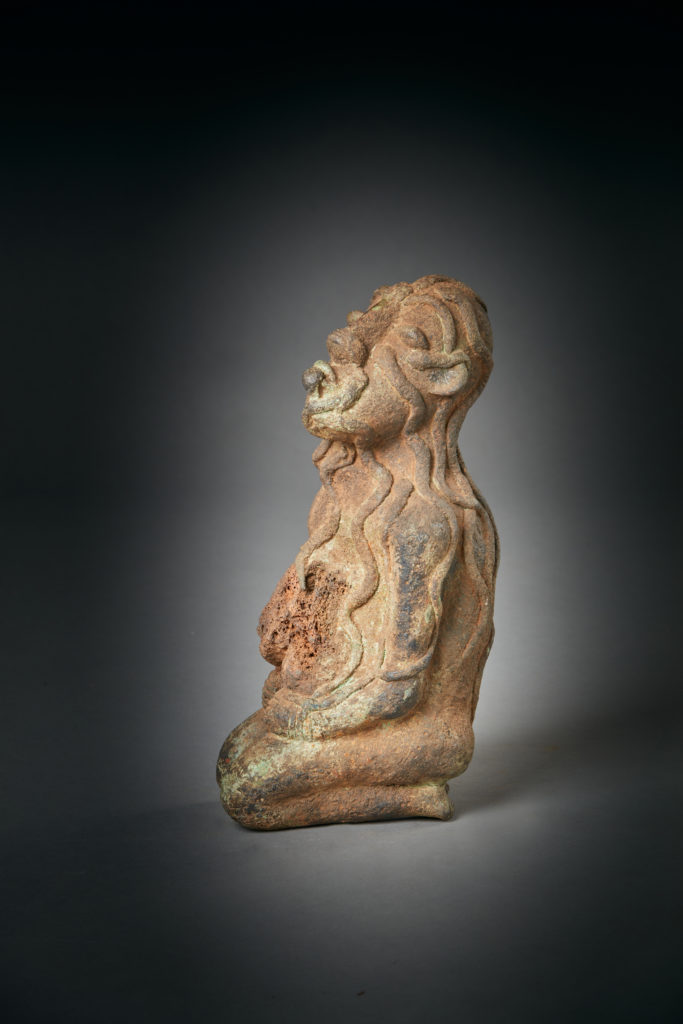


Igbo-Ukwu Bronze Maskette
Igbo-Ukwu Bronze Maskette
Circa 9th to 13th century A.D.
Leaded bronze
13 x 5 x 7 in
33 x 13 x 18 cm
This artifact is made of leaded bronze from the region of Igbo-Ukwu, Anambra State, in south-central and southeastern Nigeria, perhaps from the period of the Kingdom of Nri circa the 9th century A.D. The Nri and Aguleri people are in the territory of the Umueri clan who trace their lineage back to the patriarchal king-figure Eri. The Nri and Aguleri and part of the Umueri clan are a cluster of Igbo village groups who trace their origins to a sky-being called Eri.
Archaeological evidence suggests that Nri hegemony in Igboland may go back as far as the 9th century, and royal burials have been unearthed dating to at least the 10th century. Eri, the god-like founder of Nri, is believed to have settled the region around 948 with other related Igbo cultures following in the 13th century.
Burials
After a death, the body of a prominent member of society is placed on a stool in a sitting posture and is clothed in the deceased’s finest garments. Animal sacrifices may be offered, and the dead person is well-perfumed. Burial usually follows within 24 hours of death. In the 21st century, the head of a home is usually buried within the compound of his residence.
Different types of deaths warrant different types of burials. This is determined by an individual’s age, gender, and status in society. For example, children are buried in hiding and out of sight; their burials usually take place in the early mornings and late nights. A simple, untitled man is buried in front of his house, and a simple mother is buried in her place of origin: in a garden or a farm-area that belonged to her father.
In the 21st century, a majority of the Igbo bury their dead in the western way, although it is not uncommon for burials to be practiced in the traditional Igbo ways.
There are only a few known Igbo-Ukwu bronze masks of this similar style, period, and culture that are housed in the archives collection at the British Art Museum. With one exception, their examples don’t have a bird at the top of the head crown of the mask. Although the patina, iconography, and style are identical, the patina of these masks are consistent with the same period, circa 9th century A.D.
The eyes are characterized by a bulged representation. A long nose with broad nostrils, and slightly open protruding mouth and ears are eloquently in line with the side of the eyes. The face of this mask is depicted with a series of linear tribal tattoos or scarifications, typical of facial scarifications initiated by Igbo male cults.
The crown of this mask has four rows of loops, the first row starting from above the forehead of the mask has seven loops. The second row has seven loops. The third row has five loops, missing one at the center, and the fourth row has only five with one missing. The collar of the mask also has a series of loops making eleven in all. These loops may have been used to decorate the crown with beads or feathers ornaments, etc.
The bird has been soldered and attached between the second and fourth row in the center of the mask crown and has circular spiral symbols on the wings and tail identical to the center forehead spiral.
Provenance: The mask was first purchased from an Art Gallery in London, England, during the mid-1950s by an American art collector from northern Illinois, and later sold to a former C.I.A. agent and art collector who Maxwell Price acquired it from years later.
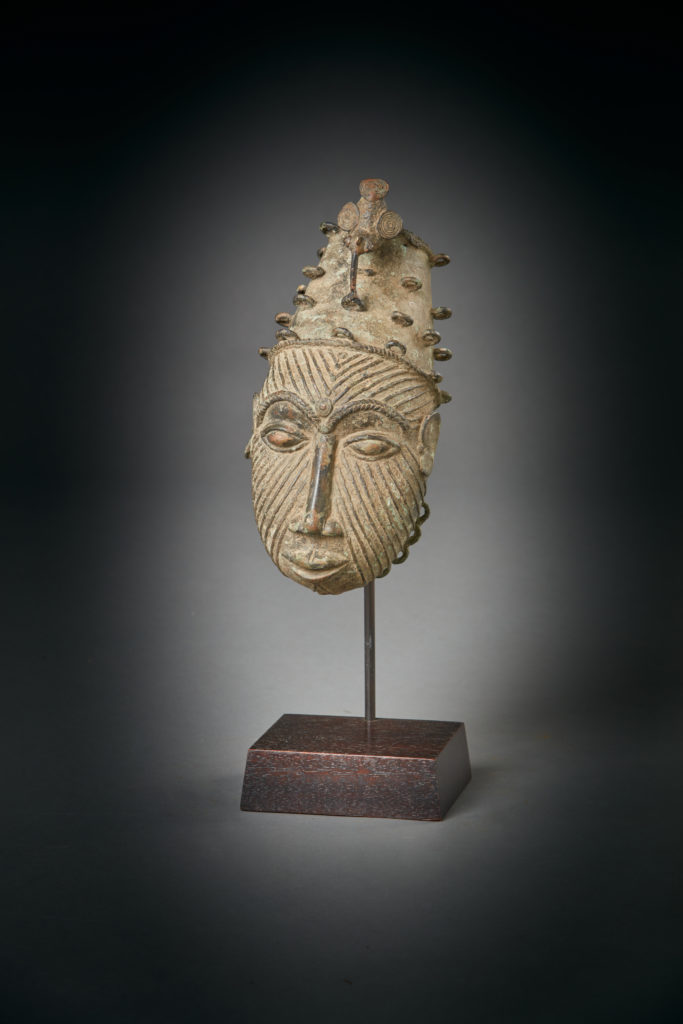
Kota: Ndassa-Wumbu Reliquary Figure
Kota: Ndassa-Wumbu Reliquary Figure
Mid to late 19th century
Wood, copper, brass, iron,
24 x 11 x 3 in
61 x 28 x 8 cm
Kota people; Region of the southwestern Gabon
Stylistically these types of reliquary figures are also found in the region of Sibiti, in the middle of the Congo; with the convex form of the domed forehead, prominent nose, and half-open mouth and revealing notably the strips of metal over each cheek. The curved lateral headdress with flared ends also exhibits the characteristics of a large, transversal crest.
The reliquary was placed over a basket containing the relics of their ancestors, and these types of baskets were preserved in temples within the village compound. The reliquary served a subsidiary function of protecting the ancestral relics from evil influences. In addition, these objects seem to have had the all-important purpose of serving as a puppet in a masquerade during tribal initiation ceremonies, which were supposed to bring the dead to life.
Provenance: Collected in 1948 by a Belgium ivory merchant, it was later sold to and published in an exhibit by professor J. Putteneers of Antwerp, Belgium, later purchased by Maxwell Price
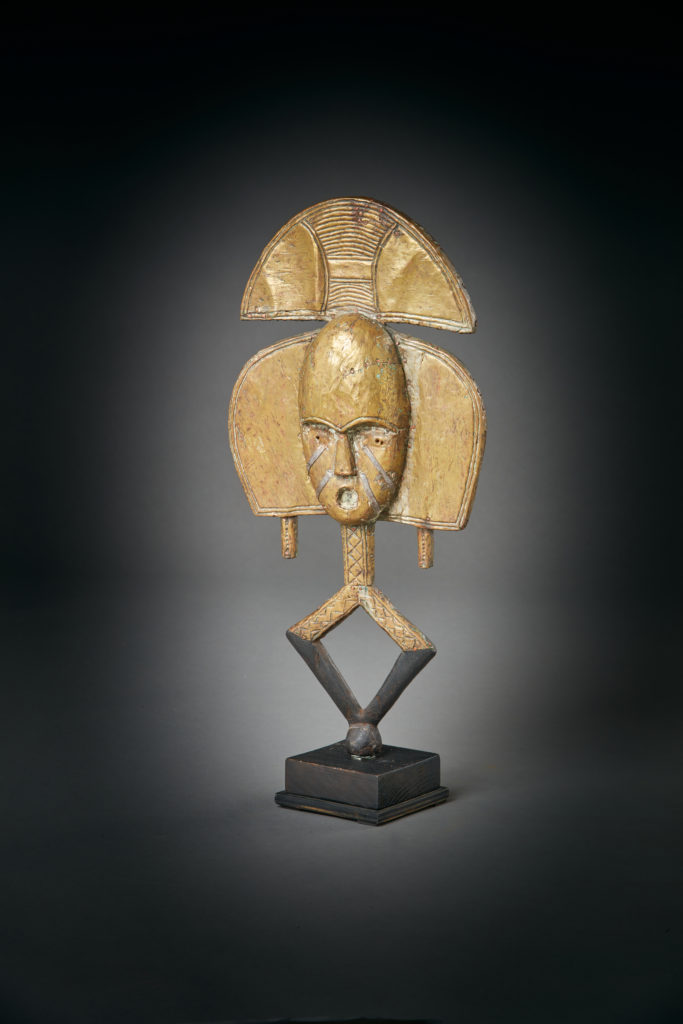

MaHongwe: Bwiti Janus Reliquary Guardian Figure
MaHongwe: Bwiti Janus Reliquary Guardian Figure
Mid to late 19th century
Wood, copper-metal
21 x 8 x 4 in
53 x 20 x 10 cm
MaHongwe people; Northeast region of Gabon, near the Congo border
Classic, rare janus double-sided reliquary figures are depicted with beautiful patina and different colored textures of the metal. Objects such as this one were guardians of the deceased and were attached to a basket, which contained the bones and remains of important ancestors. This reliquary is a beautiful example of a two-dimensional art form. Shallow-layered metal is interrupted by a projecting nose and eyes. The concave surface of the face gives the mask depth.
The MaHongwe people have links and traditions that descend from the neighboring Kota people but are themselves divided into subgroups, most notably the Bushamaye and the Bashake people, who also produce reliquaries of their own styles. The MaHongwe reliquary was placed over a basket containing the relics of their ancestors; the ancestral cult was called Bwiti, and these types of baskets were preserved in temples within the village compound. These reliquaries often had two figures on the top, one larger than the other, sizes varied from 50 cm high to 20 cm high for the smaller of the two. Janus reliquary figures are very rare and important because of its Janus style with two-sided figures, one to represent the founder of the lineage and the reverse side to represent their ancestral descendants.
Provenance: Collected in 1948 by a Belgium ivory merchant and later sold to and published in an exhibit by professor J. Putteneers of Antwerp, Belgium and later purchased by Maxwell Price
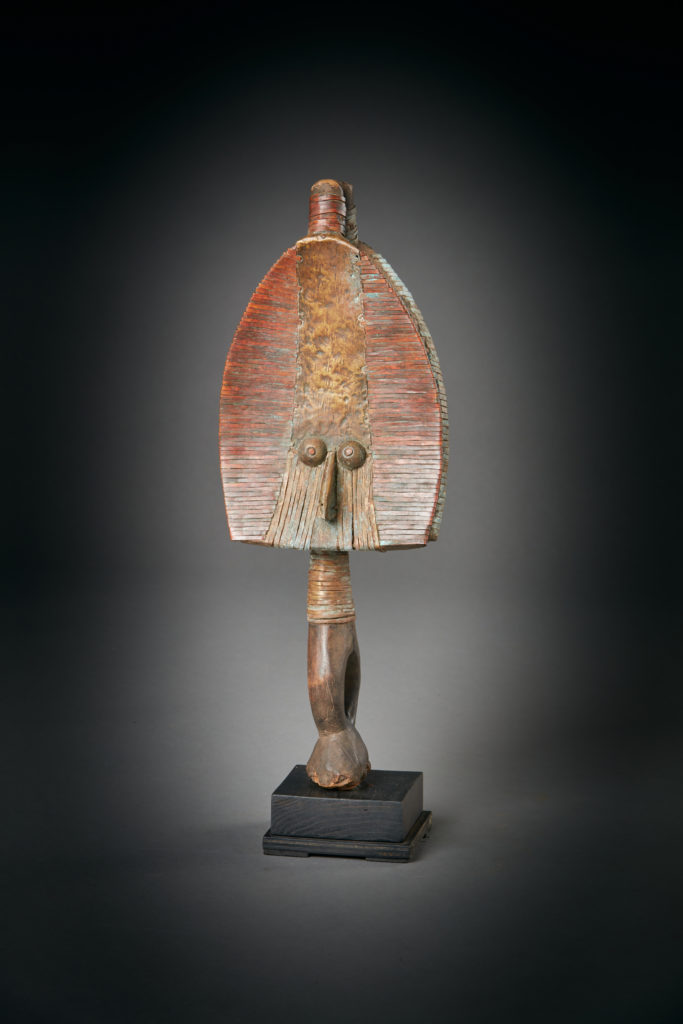
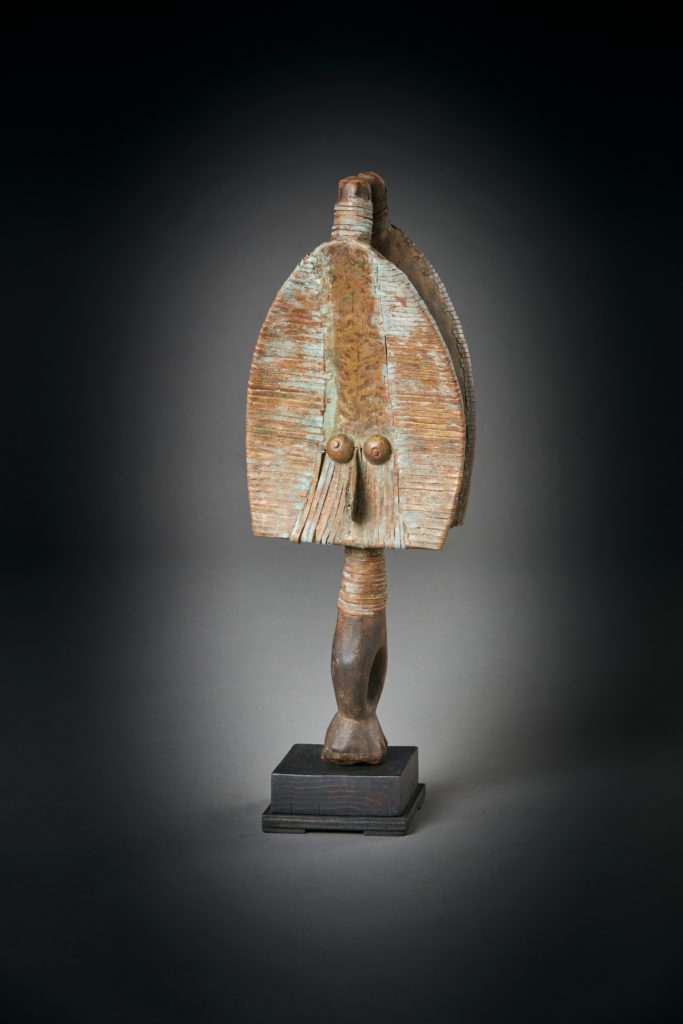
Hemba Ancestral Male Figure
Hemba Ancestral Male Figure
Circa 1930s
Provenance old Belgium collection
Wood with beautiful dark patina
32 x 8 x 9 in
81 x 20 x 23 cm
Hemba people; Region of the Zaire and Lualaba Rivers, Democratic Republic of the Congo, Central Africa
The region of the Zaire and Lualaba Rivers territories were originally inhabited by groups of Pygmies until the migrations of the Hemba people in the 16th– 17th century when they descended from the Yulu-Ya of the Tanganyika plains. This migration was led by Niembo and his son Myhiya, which in effect created the splintering of many subgroups. The Luba people tried to impose their socio-political culture upon the Hemba, but they liberated themselves from the Luba around 1850. Also, again at the end of the 19th century, the Hemba tried to resist the Arab invasion, which led to massacres and tribal raids for the commerce of the slave-trades until the early 1900s when Belgians occupied the area.
The Hemba’s religious beliefs are instituted around a supreme being which they called Shimugabo. There are many secret religious societies with rituals dedicated to their ancestors’ cult, which is of paramount importance to the Hemba society. It was only until the 1960s and 1970s that the new and previously unknown effigy figures first started to appear in Europe.
This figure is depicted in a classic Hemba-style—standing in a symmetrical position with the hands alongside the navel or abdomen of the figure, an elaborate and beautiful execution of the cruciform coiffure hairstyle. These types of ancestral figures were placed in small huts in the village compound, and they represented local chiefs or warriors and founders of their royal lineages Ex Belgium collection and later purchased by Maxwell Price
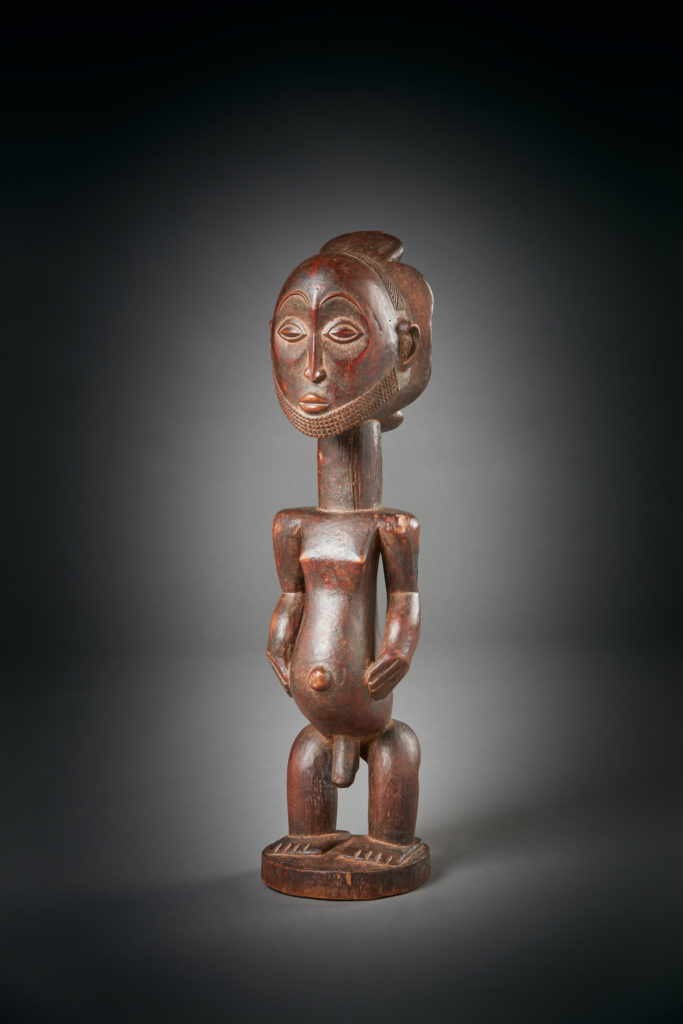

Kete: Kamboko/Nyita Ceremonial Dance Mask
Kete: Kamboko/Nyita Ceremonial Dance Mask
End of the 19th century.
Wood with white, black, and rust colored pigments
20 x 10 x 10 in
51 x 25 x 25 cm
Kete people; Region of the Lekedi River, Democratic Republic of the Congo, Central Africa
The Kete people live on the borderlands of the Kuba kingdom and share many cultural traits with the Kuba, as well as the Twa pygmies, who have also lived in this vicinity since before the 15th century. The Kete people believe in a supreme being called Mboom and also believe in various nature spirits to which many incantations and offerings are made.There is not a presence of any ancestral cult, but they do believe in the spirits of their recently deceased. The Kete people believe also in reincarnation— that after a few generations in the afterworld, the deceased returns as another human being. They believe in malevolent spirits of the recently deceased, who can harm people if not properly respected. This mask was used in funeral rituals.
The sculptural elements of this mask are in classic Kete-style, including the elongated style of chin, protruding mouth, bulging forehead, protruding conical-shaped eye sockets, and triangular tribal iconographic designs that cover the mask. The hairstyle is also classic of the Kuba and Kete people. The eye-sockets have holes that were made in and around the eyes so that the dancer might have vision; the hole in the top of the head may have been decorated with bird feathers when it was used in ceremony.
Provenance: Collected in 1948 by a Belgium ivory merchant and later sold to and published in an exhibit by professor J. Putteneers of Antwerp, Belgium and later purchased by Maxwell Price
